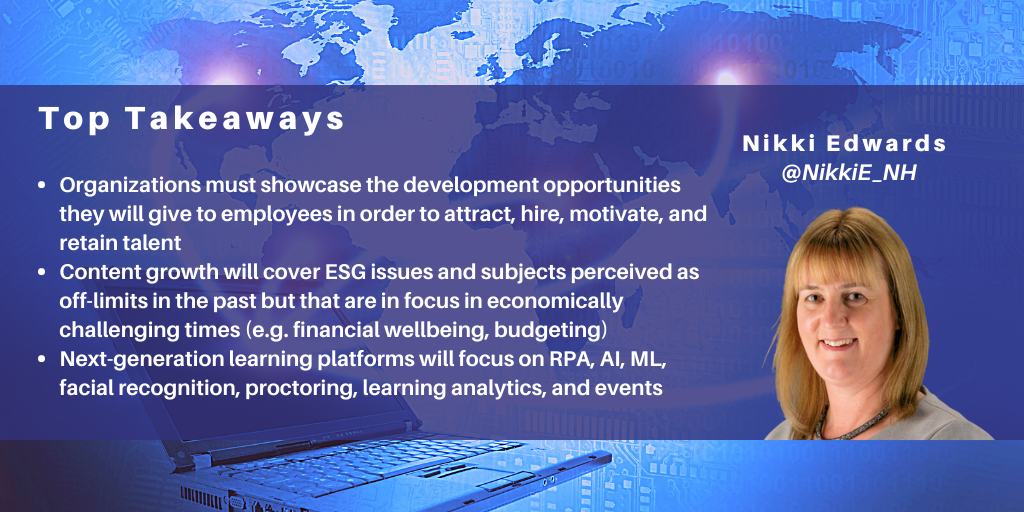
In 2022, timely digital learning became the accepted norm, along with personalized learning using delivery methods based on the latest advances in learning tech and services.
Before the pandemic, learning was a target for wholesale budget cuts during a time of economic uncertainty. With ongoing talent and skills shortages, 2023 will likely see some organizations de-prioritize learning, while others will prioritize mission-critical learning to offset talent acquisition (TA) challenges, where building skills is a viable alternative to hiring skills.
Hot topics in the learning space for 2023 include:
Personalized learning journeys
An excellent learner experience, and broader employee experience, indicates a nurturing company culture where people feel valued and remain engaged. Organizations must showcase the development opportunities they will give to employees in order to attract, hire, motivate, and retain them. Learning functions need to understand their employees’ existing skillsets, identify those they need for future business success, and identify the skills gaps to create fit-for-purpose personalized learning journeys.
Skills gap analysis is not new, but in 2023 it is disappointing that so many organizations have never undertaken this fundamental task; and this is highly indicative of why learning often fails. Many platforms now have skills ontologies built in, with RPA/AI to help drive tailored learning according to role requirements and skills interests. Platforms also support various learning modalities (video, animation, quizzes, cohorts, etc.) to engage learners, whatever their preferred learning styles, experience level, and formats (mobile, bite-sized), to provide anytime/anywhere/any device experiences. Ultimately, the aim is to motivate learners to curate their own tailored learning content, giving them the drive to own their learning/career plan while promoting a strategic and career-long learning culture within organizations.
Engaging and relevant learning content
There will be a burgeoning variety of learning content in 2023, building upon what evolved over 2020-2022. Organizations can choose whether to curate third-party content or create bespoke content, either outsourcing the task or self-creating it using authoring tools. Content around digital skills, the future of work skills, financial and mental well-being, resilience, and DEIB will continue to be in demand.
2023 will see content growth covering ESG issues and subjects that may have been perceived as off-limits in the past but come to public attention in economically challenging times (financial well-being/budgeting, healthy eating on a budget, and domestic issues, for example). Learning content is becoming life-centered, not purely work-centric, reflecting the nurturing ‘sense-of-belonging’ work cultures that organizations aspire to provide.
Learning tech/tools
Building on 2022 progress, next-generation learning platforms will emerge in 2023, providing hyper-personalized learning experiences: LMS, LMXP, LXP, and specialty platforms. Where vendors have acquired other learning tech companies, those new platforms will encompass the best features and functionality. RPA, AI, ML, facial recognition, proctoring, learning analytics, and events are just some of the focus areas.
Appification is growing, notably in bite-sized content authoring and video tech, to expand the capacity to use tech anywhere and anytime within busy schedules. While economic uncertainty looms, 2023 will likely see organizations delay large-scale learning tech purchases to minimize spending, choosing to make do with existing platforms and augmenting parts of their ecosystems with appropriate tools for specific purposes.
Enterprises may consolidate learning tech, if they have various platforms in play, to streamline learning. The appetite for data/analytics on learners will grow as organizations recognize the benefits such insights have brought to other areas of their business such as recruitment. Insights will expand beyond learners’ use of learning platforms to focus more on learner behaviors, the predictive assignment of content, and capturing the volume of content views and reactions by learners. This will enable organizations to optimize their learning content and technology investments.
Changing learning roles
Learning and learning technology advancements over the past decade have influenced and transformed L&D roles. Moving into 2023, L&D engagement will focus on addressing critical organizational issues such as developing and sustaining required skill sets. Initial job and task analysis, curriculum design, and functionally-focused career-long learning journey development projects will be necessary to ensure learning remains aligned with organizational strategies. As the application and use of HR and learning data analytics become more prevalent, demand for data science jobs and skill sets will increase.
For full coverage of the learning market, find out more by following the link below; and to subscribe, contact Guy Saunders.
Learning Services: https://research.nelson-hall.com/sourcing-expertise/hr-services/learning-bps/
]]>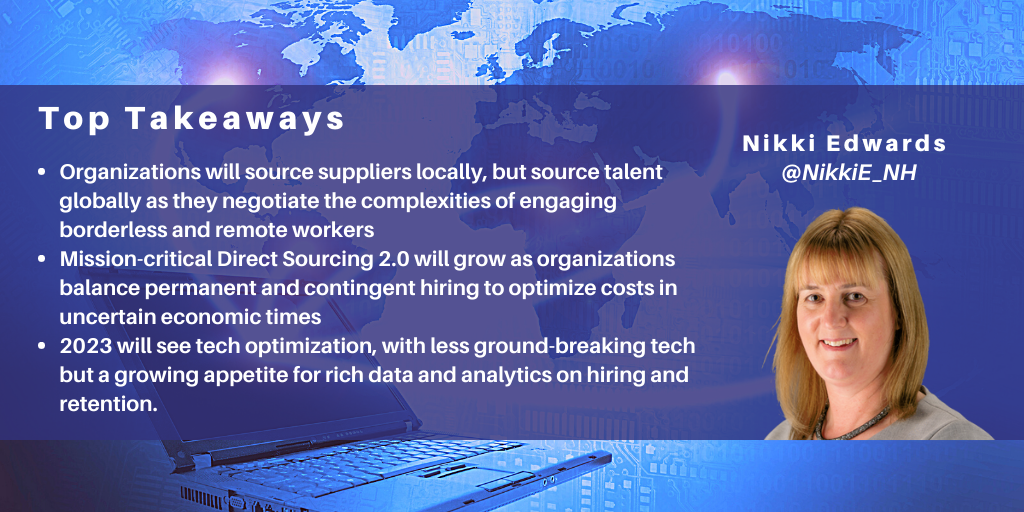
The last three years has been a period of rapid transformation for Talent Acquisition (TA), culminating in a new era of work. And in 2023, organizations face challenges such as a shrinking global workforce, skills shortages, and new workforce/workplace expectations. Alongside, broader business survival challenges (navigating an economic recession, availability of resources/supplies, etc.) and pockets of COVID prevail. Organizations will face conflicting forces in addressing these challenges; for example, local versus global, headcount contraction versus expansion, contingent versus permanent hiring, new platforms versus existing tech optimization.
Several of the hot TA topics for 2023 include:
Borderless and remote workers
While many organizations are prioritizing the use of localized (onshore) business suppliers, in contrast, their TA activities will become more globalized. 2022 exacerbated companies’ over-reliance on a handful of lower-cost international suppliers as accessibility to goods was severely curtailed for various reasons, showcasing the risks of putting all their supplier eggs in one basket. In 2023, organizations will look at local alternatives: partly to de-risk themselves while thinking about broader ESG issues such as reducing their carbon footprint. Businesses will cast their nets far and wide to find the talent they need with the right skills, building on the pandemic-induced trend of using remote workers. However, companies will have to weigh new pros and cons associated with borderless/remote workers.
A broader audience reach is a plus factor, but with more jurisdictions to cover, the risks around non-compliance increase. Understanding how to pay workers and how much to pay them has changed. For specific skillsets, talent location is now irrelevant (as the shortage is so severe, there is no low-cost alternative location, but rather a broadly similar pay expectation irrespective of where the talent is based). Part of expanding the borderless and remote workforce is well-thought-out use of diverse talent pools, communities, and gig platforms: a trend associated with Direct Sourcing 2.0 (next-generation direct sourcing).
Contingent versus permanent hiring: pendulum swing
The economic climate is already wreaking havoc in the tech sector, with well-known companies shedding workers. Still, many of the layoffs are likely the effect of inadequate right-sizing in the past (because of a lack of awareness of whether fit-for-purpose skillsets existed across businesses) or over-optimistic post-pandemic hiring (short-term reactive hiring and less strategic workforce planning).
While further recession-induced headcount reductions will likely be commonplace in 2023 across all sectors, organizations will also prioritize mission-critical headcount hiring (such as digital or niche skills, both professional and blue-collar) due to continued global economic uncertainty. However, with the global shortage of digital skills, those recently laid-off workers are seeing alternative job offers. In times of economic recession, organizations tend to increase their proportion of contingent hiring and decrease permanent hires, to reduce their risk of long-term headcount commitment and give them the flexibility to end contracts. While contingent roles are currently favored, candidates willing to embrace either role type will fare well in terms of future opportunities.
Showcasing employer/contractor value propositions
Organizations will work harder to promote their company cultures to be future-of-work fit for their audiences across all talent channels. The new priority is promoting broader environmental, social, and corporate governance (ESG) issues/credentials, in addition to diversity, equity, inclusion, and belonging (DEIB), work flexibility, financial and mental well-being, and career longevity. With tighter budgets, savvy companies will work to redeploy contract resources onto additional projects to maximize their recently-gained knowledge of the organizations where they are working rather than restart the hiring process.
Skilling 2.0 to offer career journeys
All candidates will want to understand the potential for upskilling and reskilling while working for an organization, whether for a fixed or indefinite period. The successful attraction of contingent workers will require organizations to offer exciting projects and the opportunity for upward mobility within the organization, with support for upskilling or reskilling in adjacent skills. Contingent workers who enjoy the company culture where they work will be more inclined to stay longer if the right opportunities present themselves. A poor economic situation tends to dissuade temporary workers from job-hopping.
Attracting the next generation of permanent talent, or filling existing vacancies, will require organizations to showcase potential career journeys to candidates. Job hunters will want to join companies that value them as individuals and will give them opportunities to progress their careers at their pace, without being held back.
Data, analytics, and intelligence
To attract and hire the best candidates, organizations must continue to showcase slick and speedy hiring processes, combining a mix of intelligent tech and human interaction. Rather than seeing any ground-breaking technologies emerging, 2023 will be a year of tech optimization for many organizations. Without the budget for embracing new company-wide platforms, existing stacks will be optimized by consolidating or augmenting them with tools to add much-needed functionality. Areas of interest in tech augmentation will focus on adding process efficiencies, tools measuring candidate surveys/sentiment analysis, horizon scanning (likelihood of jobs being replaced or augmented by tech), anonymized talent communities, and on-demand payments for contingent workers.
The appetite for more data and predictive/prescriptive analytics will grow. Notably, organizations will seek to identify bottlenecks in their hiring processes and aim to overcome them. Also, there will be more interest in ascertaining where and why candidates drop out of the talent attraction and hiring processes.
Additionally, HR data and analytics will expand beyond legacy usage (e.g., number of hires/separations) to strategically support all facets of an organization throughout the HR lifecycle. Examples of the enhanced use of these rich data include assessing a candidate’s cultural fit during the recruitment process, identifying employees with a high probability of separation, determining if the right types and volume of skillsets exist within an organization to meet projected product/service levels, and assessing pay and benefits at the individual employee level.
For full coverage of all recruitment markets, find out more about our specialist research programs by following the links below; and to subscribe, contact Guy Saunders.
- Contingent Workforce Services and Managed Services: https://research.nelson-hall.com/sourcing-expertise/hr-outsourcing/msp-cws/
- Global EOR: https://research.nelson-hall.com/sourcing-expertise/hr-technology-services/global-eor/
- RPO: https://research.nelson-hall.com/sourcing-expertise/hr-services/rpo-total-talent-acquisition/
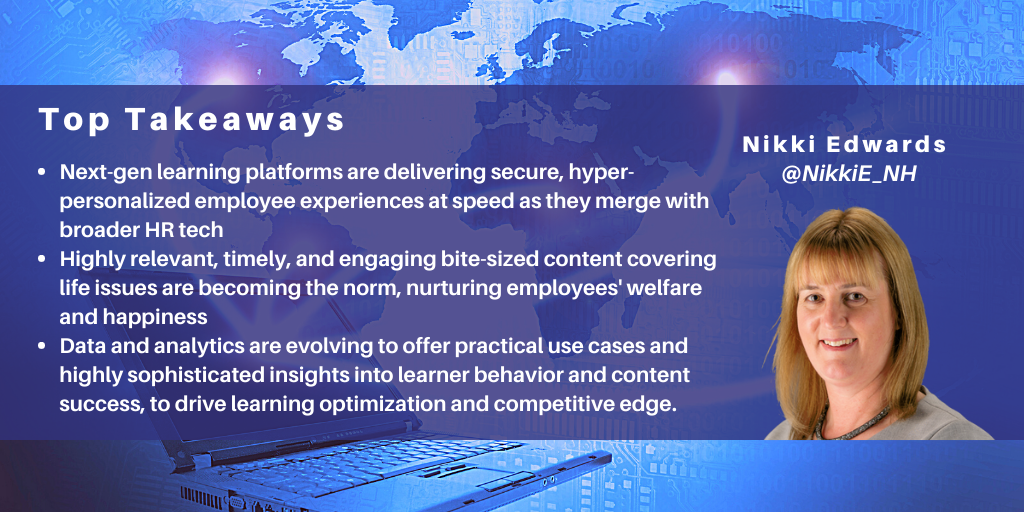
The 2022 Learning Technologies Autumn Forum (at the London ExCel, October 13) reflected the market changes and global events that have been driving the learning transformation agenda since early 2020. Remote and hybrid working demand and deepening talent and skills shortages have seen learning become a C-suite priority: organizations realize that if they cannot buy or borrow talent (via permanent or temporary hiring), they must build it through learning.
Job seekers, candidates, contractors, and employees want a fast, consumerized experience in both their private and work lives. Furthermore, if a prospective or current employer fails to provide ongoing development opportunities, employees will likely look elsewhere. Add in the current economic pressures and impact on people's well-being at work, and this makes for a highly challenging 2023.
Learning tech vendors and tech-savvy CLOs have been driving the digital learning agenda for years, and the current market challenges mean their business strategies are cut broader and deeper than before. Some core themes remain on the agenda, several of which were showcased by vendors attending the forum: next-gen platforms, upskilling/career pathing, optimized bite-sized learning, and data/analytics.
Next-gen platforms
Several vendors have made acquisitions to create next-generation platforms that will be fit-for-purpose in 2023+, taking the best features and functionality of their acquired tech. Cornerstone's 2022 acquisition of EdCast (along with previous investments) will see the best aspects of all the platforms in its portfolio come together in 2023; while LTG's platform and services portfolio, assembled over the past decade from multiple acquisitions, will continue to integrate. Both these vendors are driving enhanced learner/employee experiences.
Huler's HulerHub personalized employee experience platform layer links to an organization's tools, documents, and systems. HulerHub provides a straightforward Netflix-style interface that is quick and easy to update without coding or design expertise. The platform is carefully designed to avoid common pitfalls. For example, pre-boarding maximizes communication, while onboarding aims to prevent digital overload. Similarly, maintaining a good work/life balance is vital while giving the freedom for growth and development.
Sponge's Spark LMS uses facial recognition technology, which is invaluable for attendance monitoring in environments where fraudulent attendance is commonplace. The technology also highlights learners' boredom, confusion, or delight when accessing learning content.
Upskilling/career pathing
Several vendors, such as Cornerstone and LTG, are developing skills ontologies. These enable learners to close their skills gap through AI-driven learning opportunities and map out career paths to facilitate talent mobility. Learning Pool has just acquired People-Analytix AG, an AI-based employee skills management platform. The platform includes a proprietary multilingual skills ontology with over 20,000 skills, enabling companies to identify organizational skills gaps, uncover workforce trends, and match employees to jobs, projects, and learning. The plan is to roll out an enhanced offering now that the two companies have come together.
With its established Saffbot learning chatbot (that supports learners beyond formal training as they interact with content in real-time), Saffron Interactive launched its new AI-enabled skills coach Aida at the event.
Optimized bite-sized learning content
Learning is increasingly geared around busy lives, with bite-sized or microlearning opportunities accelerating. Several learning tech vendors operating in the education space (e.g. D2L, Frog), with deep insights into the pedagogy of learning, are emerging in the corporate arena to maximize learners' learning capacity in short bursts.
More vendors are developing their platforms with authoring tools to encourage self-created content. This option works well where organizations have company-specific information to share with their workforces that cannot be curated from a third-party provider. For example, Rise Up has fully integrated its proprietary LMS with MS Teams, enabling learning to take place in the flow of work.
However, not all organizations want to create content, preferring to use third-party providers who curate or create content for their clients. Content providers are broadening their content portfolios, making highly-relevant, timely, and engaging content. For example, Thrive provides content via its Content Club for any LMS. It has recently added content around themes such as World Mental Health Day, the cost-of-living crisis, financial well-being, and the menopause. Its catalog has a section devoted to hot topics. HowNow handpicks specialist content for its HowNowPlus offering and partners with several curated content providers.
Numerous learning techs focus on a specific learning modality (e.g. video, animation, VR/XR) geared for consumerized learning, and it was evident that appified video platforms for employee-generated content are increasing. For example, StoryTagger provides an easy-to-use app with templates for uploading work-related content in bite-size chunks, enabling learners to choose a top-level overview or dive into the details. iAM Learning uses animation for off-the-shelf and bespoke content, using story-telling to engage learners and help them retain knowledge. ARuVR (formerly VRtuoso) offers an XR Authoring System, XR Real-Time Sessions, and XR Interactive Live Streaming under one enterprise-grade platform. In-house L&D teams can add their own XR content without needing XR expertise.
Data/analytics
Sponge claims that 90% of executives say that developing employees is very important to their businesses, yet only 12% of CFOs are confident that L&D is spending the right amount of money in the right places. Evolving data maturity from being data-aware to data-driven, and building actionable insights from learning data, helps organizations to invest where they need and drive optimal business outcomes and ROI. All vendors provide learning data and reporting/analytics. Companies need to recognize the value of the resultant insights and embrace them.
Some of Sponge's standout features include detailed analytics on learners' quiz/exam behaviors: for example, seeing how much time they took to read, analyze, and answer a question or which question gave them the most difficulty. Sponge can track learner engagement by highlighting which elements or modules learners breezed through and where they struggled or lost focus.
Summary
As 2023 approaches, and with so many external challenges in play, organizations must put their workforce first and give people opportunities to grow and develop throughout their career. With the support of learning tech vendors, companies can quickly and positively impact their learners, driving workforce satisfaction, engagement, and loyalty.
]]>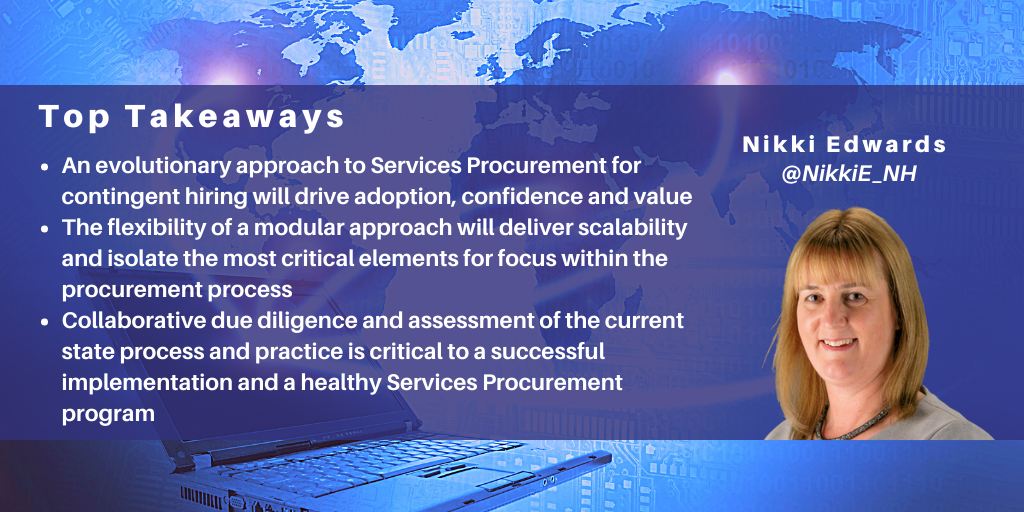
Pontoon's recently reimagined Services Procurement contingent hiring solution enables a simplified, client-centric journey, with best practice at its core and underpinned by industry-leading technology.
In 2021, Pontoon conducted a thorough evaluation of its existing offering, other solutions in the market, and what current and future clients were looking for from Services Procurement. The result is a solution designed around three primary pillars: manage the process, facilitate the buy, and outsource the category. The approach is modular, offering the flexibility needed for a broad mix of clients, with each pillar increasing in level of complexity and value. Pontoon’s client engagements range from small and mid-sized to billion-dollar global programs.
Whereas a traditional MSP is a holistic program needing organizations to embrace an all-encompassing change in their contingent hiring processes, Services Procurement and Statement of Work (SOW) can be perceived as an evolutionary service offered as a part of an MSP.
Build a solid foundation on which to grow
The aim is to start with the foundational elements of Services Procurement rather than an immediate introduction of a high-level procurement service. By starting at a managed level, procurement professionals can focus on their core business priorities, day-to-day operations can continue uninterrupted, and adoption rates are driven up.
Pontoon believes that its approach would ensure success and establish a solid foundation to build steady, manageable, and successful change, irrespective of a company’s readiness and Services Procurement ambitions.
It has deployed its new approach with a U.S.-based healthcare client who started their Services Procurement journey on the first pillar: manage the process. When Pontoon first met the client to discuss MSP services leveraging the client’s existing ATS and VMS platforms, they stated their ambitions to embrace SOW services quickly. However, cognizant of the risks of moving too fast, Pontoon followed its tried-and-trusted approach in first establishing itself as the client’s MSP vendor. The focus was on delivering results (process efficiency, visibility, compliance, and cost-savings) and building trust (achieving a consistently high stakeholder satisfaction score) before helping them navigate Services Procurement/SOW. In the initial phase, Pontoon took on some of the tasks and activities in the ATS to ensure the contingent workforce records were compliant across both platforms. Within six months, Pontoon leveraged data and analytics to identify action items to optimize the existing supplier pool, ensuring selected suppliers were best suited to the client’s needs.
As the client’s MSP vendor, Pontoon was aware that internal stakeholders had brought in SOW resources (though SOW was out of program scope), and it was therefore likely there would be a degree of worker misclassification. Pontoon suggested it run a project with the client to analyze those resources, and subsequently identified 20% as incorrectly classified. Pontoon was comprehensive and thorough during the resulting discovery process. The rigor applied from understanding how an organization’s contingent labor can be hired, hidden, and allocated in different ways enabled Pontoon and the client to gain full visibility of all SOW resources, ensuring that both parties could collectively isolate the actual SOW versus contingent spend.
Invest the time and enjoy the discovery…
Pontoon emphasizes that a successful Services Procurement/SOW program requires a methodical approach, bringing net new contracts under the program scope in the first instance and avoiding mid-contract changes. The client, with 105 SOWs in flight and 600 workers associated with them, would not be able to cope with the disruption of immediately changing all contractual terms. Similarly, the client’s existing VMS technology would require significant work to update this change in volume.
Pontoon walked the client through the Services Procurement/SOW Discovery, Data, and Recommendation steps, determining how it would implement Services Procurement/SOW and walking through every workflow step, establishing who would take responsibility for specific actions.
Pontoon identified that cost savings would be ~12% (which, projected forward, equated to $4m per year), essentially driven by the solution design team through rate card and invoicing compliance. The team determined what the client wanted from a rate card strategy perspective, backed it up with market data, and ensured it aligned the right strategy to the client’s brand perception.
Typically, these programs are supplier-funded. However, in this case, the client is financing the program, encouraging more suppliers to get on board, notably big consultancy firms. In such circumstances, this can be a harder sell to a leadership team. However, the business case created for the procurement team to present to their leaders showed the added value that Services Procurement/SOW could bring and how they would outweigh the cost of the client-funded expenses. In preparation for Services Procurement/ SOW, the tech stack for SOW was streamlined and aligned to the broader MSP – comprising the VMS and a few additional tools for onboarding and analytics.
…and the recommendations will reap rewards
The business case evolved into a complete policy change, with non-compliance post go-live resulting in withholding budget sign-off. By coincidence, the new policy gained executive approval on the third anniversary of the initial MSP launch.
Pontoon would like this client-funded model to be repeated to prospects, to drive better adoption rates and to better support client business objectives.
Pontoon is now working on the second pillar of the program's evolution. Using its accumulated data, it anticipates supporting the client with enhanced vendor selection and assessing bids so that the client can take on more strategic elements internally. It is clear that results have been delivered by taking a systematic, manageable approach, paving the way for further success.
]]>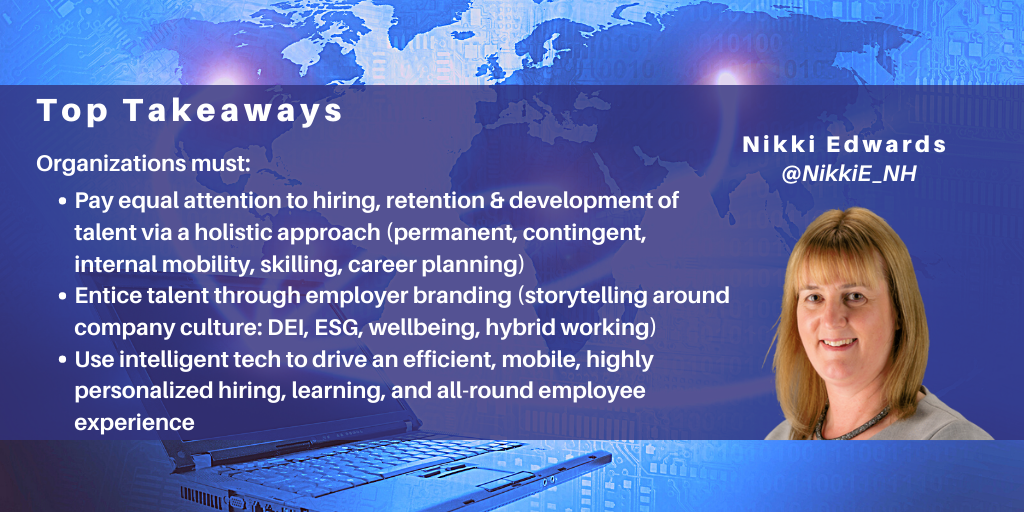
Here I look at the major trends for the year ahead in two key areas of HR: recruitment and learning services.
Recruitment Trends
Talent Acquisition (TA) challenges were already complex in the pre-pandemic period, with an aging workforce population, shortage of digital talent, rapid evolution of technology, Brexit, legal changes, and more. The pandemic added another layer of complexity in 2020: the rapid shift to digital hiring/onboarding (with some sectors seeing rapid upticks in activity), non-digital skills shortages, working from home and keeping workers safe and well. While expectations for 2021 focused on digital, hybrid working with a highly-distributed workforce, the Great Resignation presented unforeseen challenges, with knock-on consequences, requiring organizations to take a different approach to the future of work.
Organizations struggle to find talent in a highly-squeezed market, as tried and trusted methodologies no longer work. More are reaching out to vendors for support as they become desperate to attract candidates while juggling increased turnover levels of existing employees. Vendors are evolving their TA solutions in line with advancing TA trends. The hot topics for 2022 will be:
A total talent/holistic approach to hiring
Organizations will act upon their 2021 intentions, as sought-after talent is no longer guaranteed from traditional full-time/permanent channels, requiring a contingent or internal mobility channel approach. So, all organizational functions must work collaboratively to proactively strategize their 2022 talent plans via a strategic workforce planning (SWP) approach, using enabling technologies to aid the process. While some urgent talent needs may require a quick fix, this reactivity is unsustainable long-term. An increased focus on internal talent mobility will reduce the risks of unnecessary employee turnover. Organizations must also plan their salary/contractor rate positioning (avoiding neglectful over-inflation of rates) to prevent future problems around pay inequities across the workforce.
Back-to-basics recruitment
Companies are competing for talent from shrinking talent pools, as the sansdemic (decreasing working-age population) and the Great Resignation dominate the 2022 market. The most in-demand TA services will be employer branding and associated services contributing to organizations’ brands. Businesses will work hard to promote their company cultures to be future-of-work fit for their audiences, across all talent channels. Priority is on promoting diversity, equity, inclusion, and belonging (DEIB), work flexibility, safety/wellbeing, career longevity, and environmental, social, and corporate governance (ESG) issues.
In one of the most candidate-led markets in years, tried and trusted recruitment methods are becoming less effective, yielding fewer candidates. While pandemic-induced travel restrictions impact talent mobility on the one hand, on the other, more significant opportunities exist to engage remote talent globally. So, organizations must expand their repertoire of initiatives to reach candidates: international hackathon events to find future digitally-skilled talent, leveraging previously untapped audiences (career returners or those launching second careers). Companies failing to focus on these basics will lose out on vital talent.
Building talent by upskilling and reskilling organizations’ workers
Traditionally, the focus was on building in-demand digital skills and reskilling workers whose roles were being automated. Organizations must now expand the remit to offset the broader talent challenges associated with employee churn.
Essentially, TA and learning will work in greater unison. Corporate functions must plan how talent will be managed beyond initial recruitment/onboarding to drive ongoing employee engagement and development, to encourage longevity of service. A training course here and there or a HiPo scheme for a select few are no longer fit-for-purpose in their traditional formats. Long-term career mapping and initiatives to put newly-learned skills into immediate practice for all workers will be required, or workers will seek to progress their careers elsewhere. Core to this experience is using intelligent, AI-driven tech, feeding personalized content, enabling a self-service, pull approach to skilling, upskilling, and reskilling.
Next-generation platforms/tools
Hiring quality candidates at speed while driving a highly-consumerized experience will remain a priority (although hiring speed success is likely impacted by talent availability). Candidates will expect a predominantly digital hiring experience to meet the needs of a workforce seeking flexibility and being less focused on having a physical workplace presence.
Employees will expect to use intelligent tech, underpinned by sophisticated RPA, AI, and ML, via a single platform interface to drive a highly tailored and personalized day-to-day work experience (feeding relevant content to them to maximize role efficiency). Hence, there is also a greater shift to a microservices/low-code/no-code architecture as a standard. The appetite for deep data and predictive/prescriptive analytics will grow, as organizations and their workers seek insights to help eke out extra competitive edge in all areas of talent. The use of digital agents and voice-enabled technology to personalize the tech experience will be a focus in 2022.
Learning Trends
In 2021, learning focused on building out the digital foundations initiated in response to the 2020 pandemic. Hence, the criticality of using the most appropriate technology and tools to drive a digital learning experience emerged. It is now generally accepted that a predominantly digital learning approach is the way forward, focused on skilling for the future of work.
Events such as the Great Resignation of 2021, inadvertently fueling the talent shortage, have turned attention to employee engagement, retention, and development to offset employee turnover. Hence, in 2022, learning will see a revitalized focus and achieve a higher priority within organizations to curb TA challenges (as part of the holistic/total talent approach to attaining the skills needed). Learning vendors continue to develop their services and technology apace to support businesses in meeting their workforce skilling needs. Hot topics for 2022 will include:
Tailored content for skilling
Learning vendors will continue to curate content (where there is an abundance of ready-made material available on generic skills) and create content (where organizations need tailored content for a product or specialty compliance reasons). Subjects such as digital skills (from basic to advanced, niche, certified skillsets) and future of work skills (remote leadership, maintaining wellbeing), commonplace since 2020, will continue apace.
With many organizations focusing on raising their corporate profiles to attract talent, there will be demand for DEIB and ESG awareness training, living the company culture when workforces are remote, and managing employee performance/career conversations. Enhancing skills training focused on the digital world of work will include digital selling (without face-to-face engagement).
Learning tech/tools
In 2022, the technology and tools focus will deliver experiential learning, taking advantage of RPA, AI, and ML developments, driving content suited to individual learners' preferences and needs. More organizations will seek advice on replacing or augmenting their existing learning systems with LMS/LXP and other specialty platforms to ensure learning is engaging and tailored to encourage self-service/pull learning in the flow of work. Notably, Microsoft Viva will make an impact on the LXP market. Driving learner engagement will start at the candidate level via digital onboarding (supporting pre-boarding learning activities to give new employees a head start and the opportunity to reach productivity sooner).
Next-generation platforms delivering digital internships, graduate programs, academies, and certification programs will be sought to skill, upskill, and reskill a more distributed workforce, to engage and retain them long-term. The use of events platforms will also increase alongside. A mobile-first/appified and microlearning approach will dominate, enabling learning to take place in small chunks across all devices, fitting in with learners’ busy lives. For companies keen to create content internally or manage curated content, the uptake of rapid authoring tech and content library subscriptions will increase. Organizations will seek more learner-specific data/analytics to measure the success of their learning programs as the competition for skilled talent intensifies.
Next-generation modalities
The emphasis on experiential learning will drive the demand for engaging modalities, such as video, animation, gamification, serious games, and simulation. There will be re-energized demand for VR, augmented reality (AR), and the metaverse, as the technology becomes less expensive. An emerging area is haptic technology enhancing kinesthetic learning.
Other learning services
Demand for consulting services will continue, covering digitalization of learning (including tech/tools and learning content advice), reskilling/upskilling, and driving learner engagement (as retention of talent becomes a priority to avoid unnecessary turnover). Administrative services will continue to focus on systems administration and the sourcing of third-party suppliers, as more organizations decide to outsource such tasks.
]]>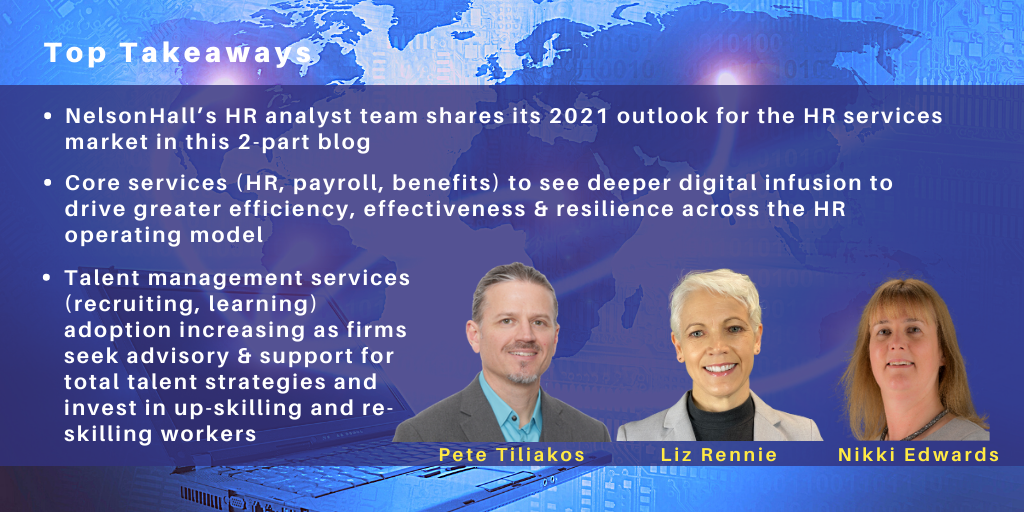
This is the second part of a 2-part blog presenting an analysis of key trends from NelsonHall's HR Technology & Services team. Here, Nikki Edwards looks at talent management services, including recruitment and learning services.
Recruitment Services
RPO and CWS/MSP vendors shone in 2020, as they supported their clients through their COVID-19 challenges, adding another dimension to an already-complex picture of Talent Acquisition (TA) trends. Vendors initially advised on digital tools to enable remote hiring and onboarding of talent, and broader services around working from home, keeping safe, and maintaining wellbeing.
This was immediately followed by vendor taskforces re-allocating resources to meet organizations’ urgent hiring ramp-ups (particularly in healthcare, pharmaceuticals, and food retail), while supporting clients who were scaling back or needed a different modus operandi. The year closed with recruitment vendors supporting their clients with mid- to long-term TA planning, as remote, and digital hiring and working were becoming the new business-as-usual.
Outlook
While organizations focus on essential hiring in 2021 amidst economic uncertainty, and realize they cannot single-handedly navigate the rapidly-evolving TA trends and ongoing pandemic challenges, they will reach out for third-party vendor support to help them strategize and execute plans to ensure they are hiring-fit and work-fit for the future. As vendors continue to evolve their TA solutions (services and tech/tools), they will also contribute to advancing key TA trends:
A total talent/holistic approach to hiring. NelsonHall research in 2020 showed 90% of major enterprises interviewed recognize the need to embrace a holistic approach to talent acquisition, comprising full-time/permanent, contingent, and internal talent (the latter having been somewhat neglected to date).
Organizations are considering using contingent workers (such as freelancers and gig workers) over full-time/permanent workers to avoid long-term employment costs. Vendors already offering total talent solutions are in a stronger position to support them, as they can vary the proportion of each delivery channel based on changing demands and relocate resources accordingly. With the need for worker compliance intensifying, giving organizations better visibility of data/insights concerning their internal talent is a growth area, closing the gap on this under-used talent pool.
Building talent by upskilling and reskilling organizations’ workers. On the one hand, organizations will continue to seek talent which is in short supply (for example, digital skills, other niche STEM skills, some trades skills). Yet on the other, those organizations will face the reality of skillsets being augmented or replaced by automation, requiring affected workers to be upskilled or reskilled in new areas.
The ‘build’ element of the buy, borrow, build, and bot approach to TA has never been so important. The COVID-19 pandemic highlighted how organizations’ digital skills fell woefully short of what is required for 2021 and the need to address this (notably in areas from basic use of collaboration platforms to advanced cybersecurity). All recruitment vendors will play a role in skills development and embrace the opportunity uniquely according to their client base and their specific needs.
Expansion of talent advisory services. With a more highly distributed and flexibly working workforce here to stay, RPO and CWS/MSP vendors will expand their portfolios to offer services around the future of work. This could encompass the evolution of employer branding/recruitment marketing services pivoted to focus on compelling EVP building – showcasing/storytelling values demonstrated by client organizations through the pandemic.
Opportunities abound in areas beyond TA, encompassing broader HR and organizational issues. Consulting will cover working with a fully-remote, globally spread workforce (covering topics such as tech/tools, employee communications, employee engagement, workforce wellbeing/safety (shielding), workplace redesign, to business continuity planning and building corporate resilience).
Next-generation platforms/tools. In readiness for the new era of work, recruitment vendors will continue investing in data, AI-based predictive analytics (for example, the impact of automation on skills augmentation or replacement), intelligent automation (looking at workflow bottlenecks), niche human clouds, and learning tech (for reskilling/upskilling). Also, chatbots, voice-enabled tools, the use of AI for resume parsing, candidate matching, and assessments will continue apace.
Learning Services
In 2020, Learning Services vendors supported clients in digitalizing in-person training content for cloud-based peer-to-peer platform delivery in a bid to continue essential training (for employee onboarding and business compliance needs). Vendors saw increased demand for specific skills training, notably digital skills and reskilling for COVID-19-specific healthcare/pharmaceutical initiatives. Within a few months, vendors were supporting clients in choosing the most appropriate modalities for delivering learning digitally, whether via simple videos or animation, for example. Although there was some return to socially-distanced classroom training at the close of 2020, organizations recognized that digital learning solutions and updated skillset training were going to be the priority for 2021 as geographically-dispersed, remote workforces become the long-term norm.
Outlook
Organizations will continue to have reduced training budget spend in 2021, until the economic situation improves in a COVID-19 vaccinated world. Vendors must maintain/increase support for their clients as they navigate further challenges, which may include the downsizing or removal of in-house learning teams, while ensuring their employees learn in a safe, collaborative environment, cognizant of pandemic-induced restrictions. Vendors will continue with their planned developments in services/learning tech/tools driven by existing PESTLE factors, yet also advance several learning trends:
Digital/virtual modalities for geographically-dispersed/remote workers. Priority will be on blended learning (with a significant proportion of VILT to enable most learning to take place remotely, with any return to in-person learning reserved for final skills demonstration/reinforcement), and eLearning. Learning will be in bite-sized chunks, embracing engaging modalities to drive self-service pull versus push learning. Such modalities will include video, animation, gamification, simulation, virtual reality (VR), augmented reality (AR), and alternate reality.
Curated content over created content. Learning Vendors will continue to curate content (where there is an abundance of ready-made material available), as organizations seek quick fixes to plug gaps in their content libraries. Created content will remain popular for niche/specialist content, where it is tailored for a specific organization or product, or for compliance reasons.
Learning tech/tools (including tech admin). Augmenting organizations’ existing LMS/LXPs/HCM learning modules with other platforms/tools to enhance the learning experience will expand vendors’ ecosystems. Platforms will include curated content, extended reality, EPSS, microlearning, rapid authoring, and alternate reality. Mobile learning, learner data/analytics, and learning systems admin will continue to grow in importance.
Other services. Consulting services will expand to focus on digitalization of learning (including tech/tools advice as above), driving learner engagement, and reskilling/upskilling, based around the new organizational structures of the future. Administrative services may increasingly focus on third-party learning vendor management, for example, as procurement teams shed administrative duties, and traditional classroom support diminishes in importance.
In Part 1 of this blog, Pete Tiliakos & Liz Rennie look at the key outsourcing trends around core HR functions, including cloud HR transformation, payroll, and benefits administration services.
]]>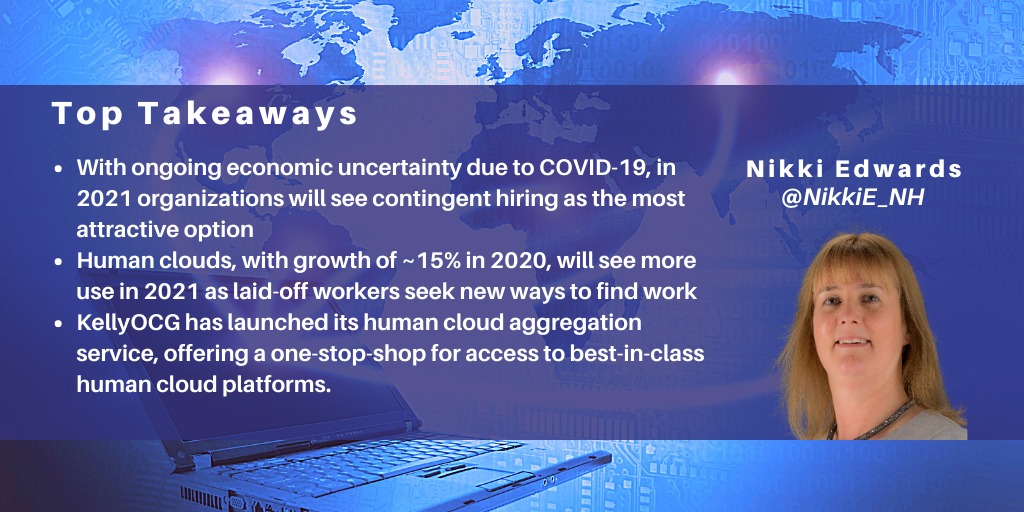
Quarterly financial reports for 2020 (April onwards) from recruitment organizations show that in a COVID-19 world, temporary hiring is more resilient than permanent hiring, faring on average about 10-30% better (albeit both types of hiring are seeing negative growth overall). Meanwhile, gig work has increased on average 10-15%, over the same period. These figures are not surprising as organizations undertake recruitment that minimizes labor cost risk. And, in 2021, with the economic situation likely to be the same as 2020, organizations will want to maintain flexibility with their workforce, making contingent hiring the most attractive option.
With a multigenerational workforce demanding more flexible working arrangements (avoiding the 9 to 5, choosing working hours, characterized by freelance or gig work), now is an ideal time for organizations to embrace a holistic (total talent) approach to talent acquisition. Organizations have also demonstrated their resilience in embracing technology/tools to enable remote working. So, now is the time for organizations to combine the two: using additional technological channels to find the flexible skilled workers they need to get tasks done, while minimizing labor cost risk in an economically challenging market.
Human clouds, where task-specific jobs, projects or gigs are carried out on demand from any location, using an online/digital platform, have seen a growth of ~15% in 2020 over 2019. And they could see a further uptick in use in 2021 as workers laid off due to the COVID-19 pandemic seek new ways to find work.
Challenges in determining the most suitable human clouds
At first glance, there are potential challenges in determining the most suitable human clouds to use, when:
- There is a choice of at least 1,800 online recruitment platforms/human clouds (KellyOCG, 2020)
- Some advertise a broad range of skills, while others are highly niche. How do you know which ones are most suitable for hiring specific skillsets?
- There are choices on human cloud/platform types: organizations would likely seek candidates by entering a direct legal relationship with an individual worker, using an online marketplace platform such as Toptal. But another option is to use a crowdsourcing platform, where several workers bid for, then independently work on, specific elements/constituent parts of a project. 99designs is an example of such a platform. In another example, restaurants refocusing their business for online delivery may use a service platform such as uber eats to seek drivers to deliver takeaway food to the public
- These marketplaces operate in their own environment, with their unique ecosystem and end-to-end process
- For procurement, it is an expensive way of getting labor (by paying separately for resources on different platforms).
One vendor that has addressed these potential challenges is KellyOCG.
KellyOCG’s one-stop-shop solution
KellyOCG has recently launched its human cloud aggregation service, offering a one-stop-shop for access to best-in-class human cloud platforms. Initially offered as part of its MSP/CWS offering, the service fills the gap in its holistic/total talent acquisition offering. The service combines human support underpinned by technology.
The Kelly Human Cloud technology (co-developed with Avature) automates and consolidates the process steps and harmonizes the profile information from each human cloud (with their unique profile formats). Some platforms involve going through a mini RFX process, where freelancers bid on the work to be done. Other platforms have a white glove hands-on approach, with a consultant that understands the requirements and finds the talent. The platform links to the organization’s VMS, enabling the hiring manager to review worker information and manage the project via the most appropriate human cloud. The system integration allows an organization to use existing invoicing and time-sheeting functionality within the VMS without re-inventing the wheel externally.
Once a new organization comes on board, it signs a client-specific contract or an addendum to a master services agreement, allowing for very easy onboarding with minimal administration. This saves the organization from needing to negotiate all the platforms separately. The organization determines whether a human cloud environment is suitable to get the work task done. KellyOCG liaises with the hiring manger to determine ground rules around using human clouds, then configures the decision-tree functionality within an organization’s VMS to determine the best hiring option. If the work can be delivered remotely (with talent sitting anywhere in the world), human clouds can work, though obviously they are not suitable for organizations that want the physical presence of a worker in an office environment.
One of KellyOCG’s clients needed to undertake quality control on 50 billboards it had set up across 50 airport locations. After posting a requirement on a platform, the client identified candidates to undertake the work of going to an airport, taking a picture of the billboard, and uploading it to enable the client to check on the quality of each billboard. The candidates received payment for the work done.
After initially reviewing eight human cloud platforms, KellyOCG settled on an initial five with which to launch the aggregation service: 99designs (leading in the creative space), BTG (Kelly major stake), The Mom Project (diversity), Toptal, and Freelancer.com. The core five cover most of the skillsets hired within its clients’ existing hiring programs. KellyOCG plans to expand the human cloud aggregation service, adding more human clouds over time.
The need to use remote talent will endure
In addition to the ongoing budgetary concerns about the cost of labor in an uncertain economic market, other restrictions remain in place, making remote talent an attractive proposition. Many countries are not processing visa applications, so workers cannot travel internationally. The second wave of COVID-19 is already well-established, potentially forcing further lockdowns at a local or country level well into 2021. Embracing human clouds should not be concerned with the “if” but rather the “when”.
While KellyOCG does not yet have any data/analytics around the usage or success of leveraging the human clouds in its aggregation service, there are some statistics that serve as a starting point. For example:
- 99designs have 20K designers working on the platform every month, and a new design is created every two seconds, with 97m designs created overall
- In 2019, Freelancer.com posted 1.9m projects
- In 2020/21, The Mom Project expects 10k projects to be posted on the site.
Undoubtedly, the number of candidates registering on human cloud platforms will increase, as more traditional methods of hiring requiring in-person interviews are stalled. Companies need to act to capture these work-ready candidates.
]]>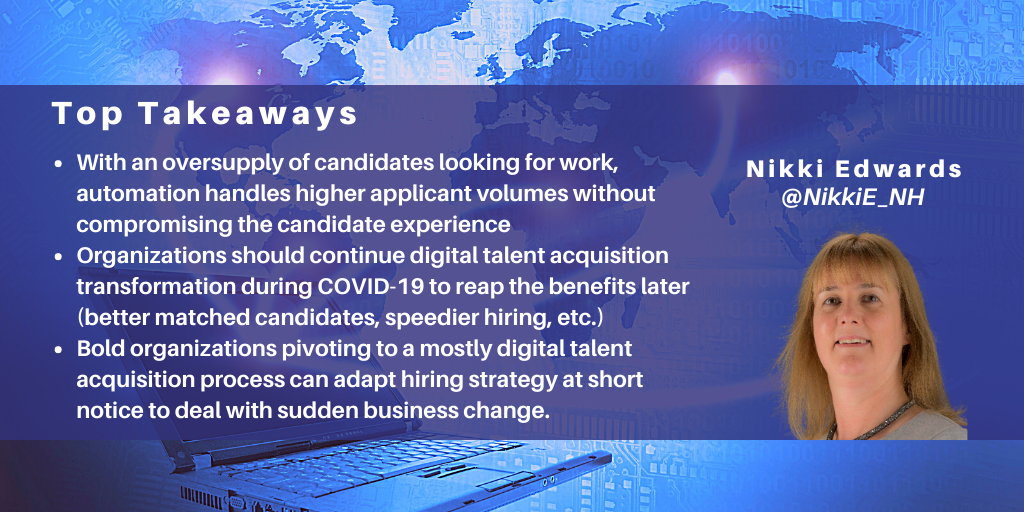
Everyone speculates as to what the long-term world of work could look like as we head into the second half of 2020 and beyond. But the reality is that we don’t really know how things will pan out. While organizations might be preparing for an uptick in hiring activity behind the scenes, the biggest challenges are the ongoing uncertainty around the future of work, and even survival from week to week.
Organizations have demonstrated resilience and agility in adapting to tech-enabled, remote, and socially-distanced operating models, often being surprised by the outcomes this has brought, notably business continuity with minimal interruptions. To continue talent acquisition (TA) activities, organizations have embraced tech and tools to aid remote interviewing, electronic signatures for documents, and remote onboarding.
However, organizations that fail to embrace such digital change, will leave themselves inflexible to sudden changes in business requirements, putting long-term survival in jeopardy.
Here, I look at three of Korn Ferry’s clients at different stages of digital TA transformation, to measure the impact of that journey on their hiring activity, as business priorities were turned on their heads.
Organizations embracing digital talent acquisition can pivot at short notice
A long-standing consumer products client, with 70% of its workforce sitting in high-volume categories (production, retail, etc.), approached Korn Ferry in 2017 to support its shift to a more digitalized approach to hiring. Using its six pillars methodology, Korn Ferry focused the client on identifying the hiring challenges they were trying to resolve. It recommended a third-party tech stack as well as proprietary tech to best enable the client’s objectives: scalability for seasonal and geographical expansion ramp-ups and ramp-downs being its priority (with the technology designed to handle candidate volume - 15,000 annual hires - at the top of the funnel).
While the funnel would normally be slow and inactive, with Korn Ferry seeking out talent through active campaign work, 2020 has seen that flipped on its head. A spike in unemployed people looking for work has transformed the client’s talent funnel to being very full and active, yet the client has absorbed the funnel ramp-up with no drop-off in service due to the scalable technology already put in place. The client can deliver a good candidate experience because the automation handles the sheer volume of applicants and screens them out if they are not suitably skilled. Having the digital capability to scale has clearly enabled this organization to pivot to the new circumstances of an oversupply of candidates.
A financial services client, hiring 30K heads annually, had fragmented, inefficient, and manual hiring processes. It was looking to digitally transform its talent acquisition function to increase efficiency and improve the candidate experience. Following a tech stack audit, it was advised to use a combination of Korn Ferry’s proprietary technology and a few select external providers. Korn Ferry Recruit (KFR) with its AI-sourcing capability would be suitable for niche roles (10K annual hires), while KFR’s Nimble platform with its chatbot and short-form assessments would be suitable for high-volume recruitment (20K annual hires). A proposed trial of an internal mobility platform was a feature of the tech stack. Many organizations keep scant records of employee skillsets. However, the internal mobility platform takes non-confidential employee details from basic HRIS records and augments them with in-depth public domain information available externally. The enhanced information acquired by Korn Ferry enables internal talent with specific skills to be identified and deployed elsewhere.
As March 2020 resulted in the immediate cessation of hiring in its retail setting due to the pandemic, there was an immediate need to redeploy employees into other roles within the business. While the recommended platforms/trial had not been implemented at this stage, there were strong indications that continuing with its planned TA transformation during COVID-19, would reap hiring benefits post-COVID-19 or in subsequent lockdowns. Benefits would include improved Time to Fill (when ramping-up numbers to meet pre-COVID BAU staffing levels), Interview to Hire, and Quality of hire measures (due to better AI matching of candidates), or easier redeployment of workers elsewhere if retail premises needed to close again.
It’s not too late to embrace digital TA and reap the benefits
The ongoing uncertainty for another of Korn Ferry’s clients (in the hospitality sector) will linger until a Government decision is made on whether to permit the mass gathering of people in 2020. And the window of opportunity for hiring is drawing ever tighter (with the final client decision for a “go” or “no go” hiring situation due in July). However, that has not prevented the client from preparing its TA strategy for this year.
The client would normally launch multiple in-person, recruiter-intensive hiring events, over five months (as it did in 2019) to find the 4.5K part-time talent needed for the Autumn season: a process that from year-to-year rarely sees the same talent apply. However, by March 2020, it was clear this talent campaign was not going to happen, so the client approached Korn Ferry for support. Korn Ferry suggested going 100% digital for its 2020 campaign – a dramatic pivot for the client, but one which would enable an instant 60% reduction in campaign duration – great when leaving the decision whether to hire until the eleventh hour!
Korn Ferry has deployed the Breezy HR platform and designed a single workflow (enabling a single application process) for six separate franchise companies that come under the remit of the client (rather than requiring six separate application processes), much improving the candidate experience. The manager’s decision to hire specific candidates is the only manual phase, with all other process steps being automated. If hiring does not go ahead, the worst-case scenario for the client is the cost associated with the consulting work undertaken in standing up the project. There will be no costs associated with the technology.
When decisions must go to the wire, with potentially 75 heads to be hired daily for 60 days, having a digital TA process clearly has its advantages. Whether the client forges ahead with hiring or reluctantly admits defeat for this year, it will be interesting to see if the digital TA set-up has changed their outlook on future recruitment for the better.
A digital TA transformation approach helps organizations embrace the future of work
Embracing a digitally-enabled hiring process does not mean sacrificing the high-touch approach. It is about achieving the right balance between technology and human interaction. Some digitalization of the TA process enables automation of mundane tasks and speeds up the hiring process, clearly giving competitive advantage to organizations. Driven by events in the first half of 2020, the technology deployed by these clients has enabled them to adapt to new circumstances when they least expected it. These case studies show how a digital approach to TA can take organizations to a new level of business agility that can help them to adapt to unforeseen circumstances at the flick of a switch. A digital TA transformation approach is highly recommended, especially when the future holds so many unknowns. Failure to embrace digital TA processes in 2020 will put those organizations at increasing disadvantage, making it more difficult for them to catch up with those organizations who have embraced digital transformation and are enjoying the benefits of being business agile.
]]>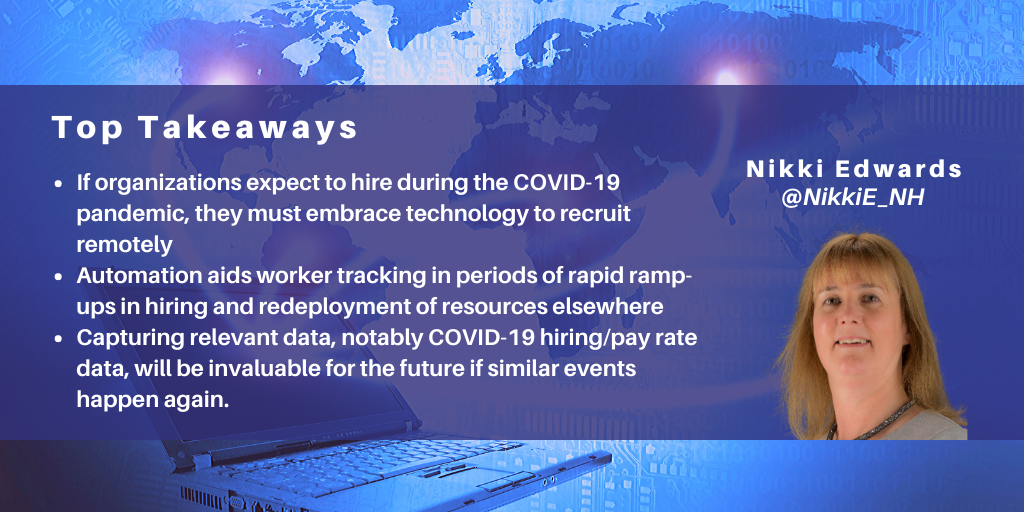
My initial research into Impact of COVID-19 on Recruitment Services: Vendor Perspective (March 2020) highlighted several stand-out dilemmas that client organizations face. Notably, some organizations need to continue hiring and the only way to do so is by embracing technology (sometimes reluctantly), enabling them to carry out recruitment steps remotely. Also, some sectors were ramping up hiring (in an already-tight labor market), while other industries had ceased all hiring activity for the immediate term. Without the appropriate technology in place, how would organizations needing to furlough workers, and end contingent worker contracts in the short-term, be able to rehire them later?
I recently spoke to Cory Hansen, VP of MSP Operations at Allegis Global Solutions, to establish how they have been helping organizations navigate the COVID-19 pandemic. I was keen to focus on their expanded (via acquisition) healthcare vertical (representing 20% of their MSP clients), the cyclical nature of demand for hiring support of contingent workers in the sector, and their use of technology to track those workers.
Allegis Global Solutions’ initial approach
Following initial focus on preserving employee health and safety, enabling its employees to work from home, then supporting its clients to do so too (by setting up its MSP COVID-19 taskforce), there was a wave of MSP clients that needed to either ramp-up or reduce their workers with immediate effect.
Within 12 hours, Allegis Global Solutions had set up a COVID-19 Operational Demand Center (with a Leader, a Recruitment Manager, a Supplier Manager, and three specialist recruiters) to control all the different client demands centrally. Being able to holistically see all recruiters and manage their movement, from program teams seeing declining recruitment to program teams seeing recruitment surges, was essential. More importantly, Allegis Global Solutions needed a grip on the movement of all contingent workers (whether those of their existing clients or new organizations reaching out for the first time for COVID-19 support).
Healthcare sector focus
The Healthcare vertical, with three clusters of clients with hiring needs at different times throughout the pandemic, would add another layer of complexity. Life Sciences (including Medical Devices, Pharmaceuticals, etc.) were ramping up hiring from the get-go. One client, manufacturing items to combat COVID-19, required an additional 250 resources, which Allegis Global Solutions delivered within three weeks, leveraging their existing supply chain. Another client needed to reach a target of delivering 100,000 medical devices to hospitals, requiring 100s of extra staff to manufacture those devices. Also, clinical clients were ramping up, but with the complexity of worker reassignment. Allegis Global Solutions uses its proprietary platform to keep track of the workers. Information stored comprises key details of the worker; the supplier representing them; the manager they report/reported to; the client they are/were deployed with; and the original requisition number. This enables Allegis Global Solutions to successfully reassign workers to new jobs and track their location so they can be hired for a new assignment or rehired in their original position, should circumstances allow.
One client, providing occupational health services, was adapting its services to support the COVID-19 pandemic (temperature screening, nurse provision, etc.), requiring tracking of their redeployments. Similarly, hospital network workers were being redeployed from areas (such as elective surgery, where demand has slumped) to ICU, which was desperate for additional resources.
Allegis Global Solutions’ proprietary technology proved its worth when it was asked by a State Governor’s office to stand up a hiring solution within 24 hours. The solution required 1000s of clinicians to be on the front line to save lives at existing and temporary hospital sites, as well as to skill nursing facilities throughout the State. Twelve hours later there was a verbal agreement in place to deliver MSP-type services for them (normally a 12-month engagement cycle) and deploy technology (a four-to-six-week process, usually). The project was to supply talent and create an outreach web portal for talent (possessing medical skillsets). The program could potentially have needed 12-15K extra hires as a worst-case scenario. Further complexity has come from the need to interface with and source talent from several existing hospital networks, which would normally be competing with each other. To date, there have been over 1000 clinicians hired and dozens of individuals reassigned from other jobs.
Allegis Global Solutions has been leveraging its ACUMEN Business Intelligence technology, too, where at the presentation layer, it can get access to as much data as it needs to see what is happening in real-time. It keeps track of all clients, what jobs are open, and what jobs have been cancelled. Also, it identifies where there is a surplus of workers who can be redeployed to another client with a spike in demand. It has been a useful repository of pay data, too. The already severe clinical staffing shortage has been exacerbated with COVID-19, as clinical workers have demanded a 30%-100% pandemic/ quarantine premium in addition to their basic pay to consider a temporary role. This data set from the pandemic will be invaluable for the future if similar events happen again.
Looking ahead
As per the NelsonHall March 2020 research, Allegis Global Solutions is one vendor advising its healthcare clients (especially frontline clinical workers) on the quickest way to leverage technology to aid remote hiring, especially for virtual interviewing (where face-to-face interviewing has been the norm), timely background screening/credentialing (including drug testing), and the virtual onboarding of workers. Allegis Global Solutions has helped clients to prioritize the components, from the most important to the least important, making concessions allowing contingent workers to start work, with checks following on later than would otherwise be permitted.
Into Q3 and beyond, essentially a lag of several months, the healthcare payer providers will see an uptick in work, resulting in a surge in demand for extra staff from Allegis Global Solutions, as end customers will make claims, require preventative testing, and the window for open enrollment looms (with expectations of enrollments being higher than ever before). This activity may be post-clinical ramp-up or sit alongside (depending on how long the COVID-19 pandemic remains at a “requiring social distancing” level). It will, however, add further data/tracking insights into the impact of the COVID-19 pandemic via its proprietary platform and ACUMEN. When the pandemic is over, it will be interesting to see the patterns of reassignment and rehire of workers throughout the period.
Conclusion
For me, what the COVID-19 pandemic has highlighted is that organizations have left themselves exposed through their slow uptake of digital transformation (especially in the recruitment space). On a positive note, it has made everyone aware of the importance of technology in their daily lives (and how it has enabled organizations to have some level of business continuity). It has forced organizations to embrace digital transformation at an initial break-neck speed, such that there is now no turning back. The Allegis Global Solutions case study highlights that organizations cannot embrace digital transformation/ recruitment transformation single-handedly. Organizations must seek out a suitable partner who can guide them on their transformation journey.
]]>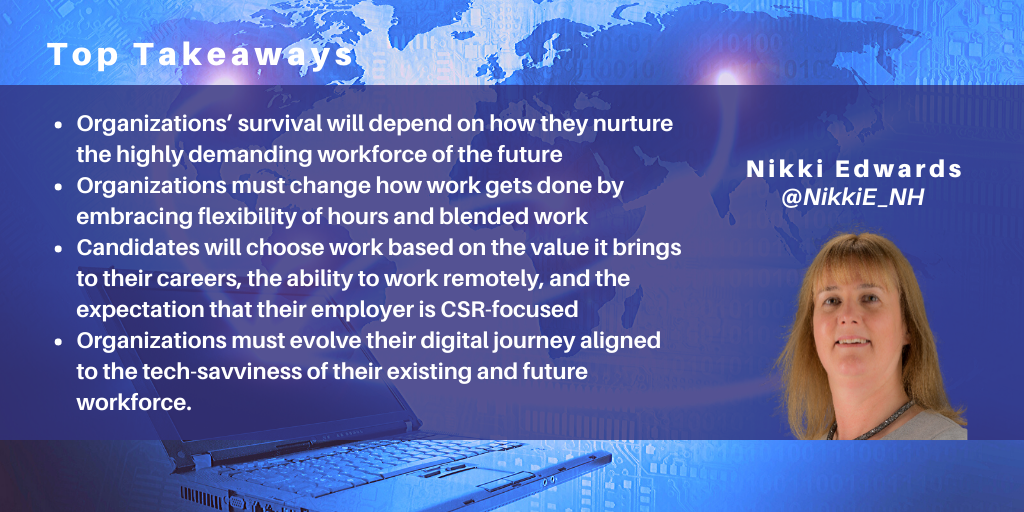
As a “Gen-Xer” I look back over my career and can identify four out of ten organizations that had an incredibly positive influence on my life. What made that 40% stand out was that, despite economic market forces, technological change, evolving customer/consumer habits, and skills shortages (as new technical jobs evolved), they successfully adapted to change. They also evolved their workplace cultures to keep workers (typically a mix of three generations) engaged and motivated to perform at their best. The workers could look holistically at the challenges faced and work creatively (often thinking outside the box) and collaboratively to overcome them through the good times and the bad.
Only the fittest will survive
As we begin the 2020s, I believe that the challenges faced by organizations are essentially the same. What is different is the pace of change (or transformation), the complexity/interrelatedness of the factors (through globalization/internationalization, the need to be data-driven, etc.), and the number of organizations now facing those challenges. What worries me is that many organizations are still not driving the cultural/mindset changes needed to thrive in the 2020s workplace of the future (a five-generation workforce enabled by technology), adding further complexity to the mix.
NelsonHall’s recent RPO, MSP, and Learning research projects each identified that one of the main barriers to organizations transforming their talent acquisition or learning strategies continues to be their unwillingness to collaborate on business-critical issues, choosing to operate in (and protect) their functional silos.
The harsh reality is those organizations will not secure/retain the talent they need and are unlikely to survive the decade!
Looking at the small details such as flexible working can make a big impact
With unemployment levels in many advanced nations set to remain below 5%, the nearer to zero unemployment rate that may present itself as the U.K. leaves the EU, along with the 2020s workforce having many demands, organizations will have to work extra hard to keep existing workers/attract new talent, if they are to remain competitive. They must nurture their workforce and evolve their workplace cultures to meet their needs.
An aging population and five generations of workers (35% of them being over 50 by 2022 according to the CIPD) bring complex issues and demands. A higher proportion of older people living with medical conditions means that more Baby Boomers, Gen X, and older Millennials face carer duties, as they must look after elderly parents. This could require workers to break up their working day into two or three parts to fit around caring duties. Similarly, advances in medicine mean that workers with acute/chronic conditions can work around their treatment regimen. With much emphasis on employee/worker physical and mental well-being, more workers (irrespective of generation) want to break up their working day by attending an exercise class or mindfulness session, at a time when they are least productive (when their concentration levels dip). Gen Zs like face-to-face social interaction, security, and hold values around diversity and inclusion.
Organizations must examine how they can change the way work gets done (to be efficient, cost-effective, productive, etc.), by embracing blended work, using non-employed workers (to benefit Millennials’ preferences) as well as employed workers, so it is a win-win situation for all parties.
My 2019/2020 NelsonHall research showed that many RPO and MSP vendors have stepped up to an enhanced service excellence model, with the aim of providing unrivaled customer experience to their client organizations so as to give them a competitive edge. One vendor hired a “Manager of Small Things” whose remit was to make incremental improvements in service delivery that make a big difference. On a smaller scale, some RPO/MSP vendors are using AI and data-driven insights to look at the optimum window when workers are at their most productive. With positive client feedback, looking at the small details can make a big impact on the workplace. It is a shame that so many organizations fail to recognize this and are determined to stick to the old ways of doing things.
According to the IWG Global Workspace Survey 2019, 80% of respondents said when faced with two similar employment offers, they would turn down the one that didn’t offer flexible working. 85% of companies confirmed that productivity has increased in their business as a result of greater flexibility. Organizations be warned!
Big issues such as remote working also need to be considered
Millennials thrive on technology (from workplace apps that increase mobility to virtual workstations and cloud-based collaboration tools), so organizations must offer flexibility that gives them the option to work remotely, attend meetings virtually, and collaborate online rather than in face-to-face meetings. With the ongoing global skills shortage, candidates with in-demand skills are leveraging gig platforms more to seek out their next opportunity (enabled by global interconnectivity). In the 2020s, candidates will choose their work based on the value it will bring to their careers and will do it remotely from anywhere in the world. Organizations need to embrace the idea that if the work gets done, it doesn’t matter where it is carried out. RPO, MSP, and Learning vendors are adding new tech/tools to their ecosystems that enable a much more flexible approach to working (anywhere, anytime, and any device), paying attention to multigenerational needs. Recruitment vendors are adding gig platforms/Direct Sourcing platforms to their tech stacks.
With several news-dominating incidents over 2019/2020 (Amazon fires, Australia fires, the melting Antarctic icecap, Coronavirus, etc.), these concerns are at the forefront for all generations of workers. The 2020s will require organizations to significantly step up their CSR focus on these issues. Introducing more remote working, enabled by technology, will help reduce organizations’ and individuals’ carbon footprint. Reducing the need to commute/travel to an office (the knock-on positives of reducing traffic/air congestion and emissions, alleviating a creaking and unreliable transport infrastructure, and avoiding highly crowded environments, etc.) would support increased worker well-being, productivity, and engagement. Longer-term, climate change and natural disasters may force populations to relocate, so organizations embracing remote working as a workplace cultural norm could be less impacted by such an event.
Digital resources will play a growing part, but not at the expense of humans
All generations of workers have embraced technological change to some degree, especially in their personal lives. According to Apple, the 2018 average daily smartphone screen time was 136 minutes for Baby Boomers, 169 minutes for Gen X, and 205 minutes for Millennials. The consumerized and personalized use of apps as part of everyday life has touched everyone (thanks to Uber, etc.). The convenience of using any device, anytime, and anywhere is the new norm. Gen Zs are known as the first fully digital generation, with 40% of them self-identifying as digital device addicts. Gen Zs can quickly and efficiently switch between work and play, working on multiple tasks with various distractions going on in the background (the multi-multi-tasking generation).
Organizations must evolve their digital journey aligned to the tech expectations and tech-savviness of their existing and future multigenerational workforce (from initial talent attraction through to exit from the organization). This requires more effort than operating in tech silos. It is about creating a joined-up strategy that will keep the workforce engaged, motivated to perform well, and retained through the future challenges those organizations will face.
As a starting point, organizations need to leverage their existing platforms better. Firstly, this means ensuring features and functionality are “switched on”. NelsonHall’s research into RPO, MSP, and Learning services highlights that a lack of visibility of data causes organizations to make poor business decisions, the stumbling block being getting access to the data, not the lack of it. Secondly, it means plugging and playing appropriate new tools to enhance the user experience of those legacy platforms (maximizing opportunities to automate and speed up processes).
Fall at any of these hurdles, and the Gen Zs will be off to another organization. In many cases, organizations may need to explore new ways of using technology. For talent attraction, that may involve campaigns across different social media platforms, “a day in the life” video footage for a specific job, and one-click apply through an app. For onboarding/induction and ongoing skills training, it may involve bite-sized sessions (to fit around busy lives), accessible 24/7 on any device, using engaging modalities (gamification, virtual reality, etc.). With 60% of Gen Zs preferring to learn through YouTube tutorials and videos, enabling the workforce to undertake self-paced, pull learning is a must.
So, will your organization struggle for existence in the 2020s, or embrace a workplace cultural change?
The struggle for existence will intensify for organizations in the 2020s. Their ultimate survival will be determined by how those organizations nurture the highly demanding workforce of the future. It is doubtful that organizations can embrace this change single-handedly. They might need to seek expertise from MSP, RPO, or Learning vendors. What is clear, though, from NelsonHall’s research, is that there are lots of opportunities for the vendor community to enhance/develop new services around the culture of work for the 2020s workplace of the future. Both vendors and organizations can race to the top. Those who get there first will be the winners.
While only some workplace cultural issues have been the focus of this blog, there are other areas where organizations need to work hard to be future-fit. Rest assured, if the multigenerational workforce feels neglected in any way, or feels that the workplace culture is misaligned in terms of their values, it will seek refuge elsewhere. As I look back at the 60% of organizations I have worked for that didn’t make a positive impact on my life, I know that some will no longer exist at the end of the decade! Where do you want to be? Make your choice!
]]>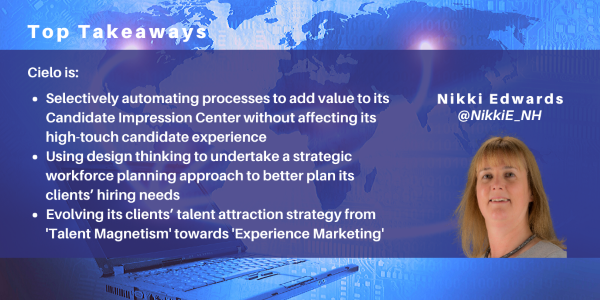
The pace of change in RPO and contingent worker outsourcing has been unprecedented in recent years due to technological advancements and the range of services expected by buyside organizations. Cielo recently organized a customer and analyst day to explore what talent acquisition (TA) might look like in the next five years.
Speaking with several of Cielo’s clients, they comment on Cielo’s enthusiasm to question the status quo and ask how things can be done better, and on its keenness to continuously improve and be future-fit while maintaining its core values.
Automation must complement high-touch service
Clients cite Cielo’s “WE BECOME YOU” mantra as a feature of its RPO service. They value the Candidate Impression Center and Bridge pre-employment service, established in 2010 to address pain points in the recruitment process (such as a lack of contact with candidates once they have applied for a job, and post-job offer before the employment start date). Given the current focus on candidate experience, remaining high-touch is key. With Cielo’s Candidate Impression Center, a chatbot now provides a response to the top 100 FAQs to save agents’ time, with humans doing more meaningful and highly personalized candidate-care work.
The RPO journey is becoming a Total Talent expedition
Cielo aims to adopt a partnership approach with clients, taking them on a journey of improving both efficiency and effectiveness in their recruitment processes. Enhancements to the service have included SkyRecruit, reporting and analytics (SkyAnalytics), Employer Branding (EB), and most recently consultancy services in areas such as TA strategy, tech advisory, marketing, and diversity and inclusion. The shortage of talent in many skills areas has spurred Cielo to look at alternative sources of talent such as contingent workers and developing existing employees to plug supply gaps, taking more of a total talent acquisition (TTA) approach.
Cielo is now taking the partnership approach to the next level with its Client Success Program. Using Cielo’s Talent Acquisition Maturity Model, clients are presented with a scorecard to determine their position on the RPO/Total Talent journey at various points through the relationship. Using design thinking, Cielo undertakes a more strategic workforce planning (SWP) approach to better plan its clients’ hiring needs to help them improve their talent acquisition maturity.
Next-generation delivery – “Certified to Serve”
Cielo posits that delivery excellence requires more than expertise in sourcing talent and industry sector knowledge. In its “Certified to Serve” initiative, Cielo’s talent advisers are required to be knowledgeable in hiring process definitions, operating principles, talent options, payrolling/invoicing, plus information specific to the client. Those with more advanced skills can advise on SWP.
Enabled by technology or driven by technology… a matter of preference
Cielo has seen early traction with its more automated High Volume RPO (HVRPO) platform launched in 2018. Several clients are using HVRPO in conjunction with Cielo’s SkyRecruit platform, typically hiring in high volume for niche/specialized roles. Examples include:
- A pharma that has made 4,000 hires through the HVRPO platform and has seen an 11% decrease in time to accept an offer
- A food service company that has made 5,000 hires and saved 1.5 hours of hiring manager’s recruitment time per hire through tech-enabled screening.
While at present Cielo’s clients mainly leverage recruitment technology as an enabler with limited automation (confined to processes that are already successfully automated in the wider market, such as website apply, interview scheduling, etc.), Cielo anticipates that in future more of its clients will leverage Cielo’s HVRPO platform (with programmatic advertising, mobile apply and assessments, automated matching, interview scheduling, and offers/onboarding) to drive the hiring process.
The “Experience Marketing” experience
Successful hiring requires a talent attraction strategy (making use of EB services) along with candidate sourcing. Cielo’s clients have embraced what Cielo calls Talent Magnetism (recognizing the importance of websites, campaigns, social media, and EVP in the TA process). The next phase is Experience Marketing (focused on EB and communications), which tailors marketing and communications to the stakeholder (the client, hiring manager, candidate, and employee team member).
What’s next?
Cielo has reimagined and redefined its RPO offering, but what will be next? With the global skills shortage worsening, the blurring of the lines between permanent and contingent hiring to secure talent to deliver a business outcome may no longer be enough. It is already apparent, with the accelerating sophistication of technology/tools, that the current workforce is not sufficiently digitally capable to embrace the tech-driven workplace of the future.
If the required talent cannot be bought or borrowed, then it will need to be built. Organizations have the choice to seek expert help from both recruitment and learning outsourcing vendors, but as seen with TTA, why would you leverage multiple providers to source talent when one provider could be more efficient, effective and cheaper (especially when the available talent plays in both pools)? Savvy RPO, MSP and TTA vendors could become Talent Management experts, blurring the lines between talent acquisition and talent development. Cielo aims to become a “Talent Outcomes and Talent Experience” company. Does that mean it will further reimagine and redefine its portfolio and become a Talent Management vendor?
]]>
Earlier this month, Allegis Global Solutions (AGS) launched the QUANTUM Platform™ to the U.S. market. QUANTUM is a workforce acquisition (WA) framework comprising a total talent strategy, a sourcing methodology, and a technology platform all in one. 18 months in the making, the idea was initiated about a decade ago, as discussions began around the roadblocks associated with having separate RPO and MSP programs and data/information stored in disparate systems. While WA programs and tech/tools ecosystems have evolved significantly since 2008, throw in the worsening global skills shortage and it becomes blatantly clear that a new approach to acquiring talent was badly needed…. hence QUANTUM, which consists of:
- QUANTUM Strategy: to help clients fill jobs and get work completed in the most efficient/effective way
- QUANTUM Methodology: AGS’ proprietary workforce acquisition methodology, providing clients with a single-entry point to all types of workers (permanent, temps, contractors, freelancers/gig workers, and consultants) via the QUANTUM Platform, with advisory support from AGS in how to best go about leveraging those workers to get work done
- QUANTUM Platform: sits across all other technology platforms and uses AI/ML, underpinned by its analytics, to bring together all types of talent from other sources into one place.
Here, I take a pragmatic view of QUANTUM based on what is generally happening in the marketplace around WA frameworks and my recent demo of the QUANTUM platform. The strategy of “getting work done” is one of the hottest talking points for vendors at contingent workforce events at present, with a few of the key vendors established in the MSP and RPO space currently developing a WA framework to address the issues described above.
The associated methodologies applied to help clients get work done are unique to each vendor: a reflection of the vendors’ history, their strengths/expertise, and the challenges faced by/needs of their clients from a geographic, industry, size, skills, and outsourcing maturity perspective. The methodologies aim to give clients a number of options for how to get the work done based on insights from the vendors’ unique data, associated analytics (via a platform), and the vendors’ internal experts (consulting).
QUANTUM Platform
Talent platforms like QUANTUM Platform enable a hiring manager (HM) view, a supplier view, and the program office view. When each new talent platform emerges, though, there is an expectation that it will leverage some of the latest technology features/functionality available. QUANTUM Platform does not disappoint from that perspective. Features include:
- Ability for a HM to search for talent by carrying out a people search (like window shopping) or load in a job description
- Elastic search (enhanced AI matching and stack ranking) by matching candidate skills with those skills necessary to perform the open positions. Elastic search also allows HMs to view stack ranked candidates based on skills and experiences. Candidates are sourced from different talent clouds:
- Supplier contractor talent cloud
- Redeployed contractors (who have come out of an assignment ready to go elsewhere)
- Client-sourced talent cloud (retirees, alumni, veterans, interns, etc.)
- Freelancer talent cloud
- Service provider consultants (SOW and service procurement)
- Full-time candidates (from an ATS, silver/bronze candidates)
- Existing employees (full-time employees who can assist on project work, who are searching for a new internal career opportunity)
- Ability for AGS to save time at the face-to-face intake meeting (with automated search results enabling a slate of talent to be in front of the HM the same day, at least a 50% reduction over the standard process)
- Ability to fill jobs more quickly (trials to date showing a 65% reduction in time to fill on average). 50% of roles have been filled with talent sourced from the QUANTUM Platform, 50% have eventually gone out to competitive bid
- Underpinned by sophisticated data/analytics:
- For example, QUANTUM’s data might show that a local software developer has an average time to fill of 34 days, but there is a qualified freelancer in another market who has just become available and can start immediately. AGS can leverage that freelancer and alert the HM to engage the person immediately (the freelancer being a resource that the HM would never even have considered previously)
- QUANTUM’s market data (comprising supply and demand data, predictive analytics about location, job market, competitor intelligence) is used to provide a hiring scale to indicate hiring difficulty: focusing on potential candidates, positions currently posted and average post duration. If a particular market has a higher score (more difficult to fill), then AGS consults with the HM to see if they can adjust the skills (to make it easier to get more candidates), or choose a different recruitment channel (use a retiree rather than a traditional temporary worker, etc.) or a different location/relocation
- Ratings for candidates (given by HMs for work done):
- Creating better matched quality opportunities for candidates
- Building up a database of good/better performing candidates for HMs to leverage
- Enabling suppliers to review HMs’ selection and buying behavior: seeing which of their candidates are showing up most in searches, and which are more successfully placed in certain clients over others
- Automatic Alerts:
- Notifications for HMs to alert them when new relevant talent enters the talent clouds, omitting supplier spam, as only the top candidates are presented (based on ratings given)
- Suppliers receive frequent updates on the status of their candidates submitted (in the hiring process, or if a candidate has become inactive due to a lack of activity on their profile) as well as general alerts (when the rights to represent candidates is close to expiring or an assignment is ending).
AGS’ Support in QUANTUM Methodology/Strategy
All vendors operating in the outsourced TA space are improving their internal expertise/capability to some extent in a bid to gain competitive edge in the race to find talent. The initiatives embraced to do this vary from vendor to vendor, aligned to their strengths and the desire to exceed their clients’ expectations. AGS’ recruiters bring a more proactive consultative approach, based on their experience/skills learned, which includes:
- Approximately ten years’ recruitment experience and seven years in professional recruiting roles managing all aspects of the hiring cycle
- Expertise in sourcing, experience with consultancy advice
- Analytical skills to understand the business intelligence data/search for market data to advise the hiring manager (HM) accordingly
- Strong consultative/communication skills to work well with the HMs and the suppliers (ensuring their recruiters are sourcing and pipelining the right types of talent), working to hiring plans and having the confidence to advise on adjusting hiring plans/sources of talent according to the market situation
- A partnership approach: moving away from a siloed approach to filling roles (permanent or contractor)/going on gut feeling, to finding the best route forward (any sourcing channel mix to reduce time to fill/increase quality/tenure) to get work successfully completed
- Initiative to drive their clients to increase the current U.S. national redeployment rates (7%) to save time/money for their clients, (including moving resources between permanent and temporary forms of work.
Future rollout outside the U.S. will be determined by client demand (although AGS perceives the most likely locations next in line will be Europe and APAC). AGS ensures they will meet all the compliance needs in the specific markets first (GDPR, etc.).
Summary
More vendors in the outsourced TA space are adopting a WA framework approach, and this pattern will continue into 2019. Some frameworks are total talent focused, others are permanent or contingent worker focused. Vendors with established frameworks include: Agile One, Alexander Mann Solutions, Cielo, HudsonRPO, KellyOCG, PeopleScout, Resource Solutions, and TAPFIN. Other vendors are currently developing/refining such frameworks. There is no “one-size fits all” WA framework solution. Buyside organizations, cognizant that vendors are taking this WA framework approach to sourcing talent seriously in the best interest of their clients, must still go through a due diligence process to ensure they choose the vendor that is right for them.
]]>
With increasing pressure on organizations to find the best hires, talent acquisition (TA) teams are continuing to grow. And as more Gen Zs are joining the workforce for the first time, so too are the latest generation of virtual assistants or chatbots. Here I look at the early careers and future prospects of Ari and Mya, two virtual assistants currently being used by TA vendors and corporate TA teams.
Ari
Ari from TextRecruit, now a wholly owned subsidiary of iCIMS Inc., is a customizable recruiting chatbot that uses natural language processing and machine learning. Ari has shown potential from the start, has taken on more responsibility over time, and looks set to advance in 2018 and beyond. Ari supports TA teams by interacting/chatting with candidates on their preferred technology (mostly smartphone) by text, live chat and Facebook messenger (via JobChat and TextApply).
The chatbot completes administrative tasks (up to 80% of candidate communications) using the TextRecruit candidate engagement platform for keeping records, which enables robust analytics on hiring patterns or metrics, ensuring latest compliance with data protection. Ari’s expanded responsibilities include working with TextHR (onboarding candidates and improving internal employee engagement) and TextReach (communicating with project resources).
Ari initially supported candidates in ‘deskless’ environments (e.g. healthcare and retail jobs) but has developed knowledge across other jobs and sectors. Ari’s day-to-day tasks include sending job postings to candidates, screening, scheduling candidate interviews, and answering organization-specific questions.
The chatbot also undertakes regular training such as learning organizational information specific to each customer (industry, business unit, location, functions, skill levels, etc.), including any updates to that information. Building on an earlier (2015) integration of TextRecruit with iCIMS via UNIFi, the new 2018 relationship with iCIMS will enable Ari (and TextRecruit) to be a core component of the iCIMS Recruit, Connect and Onboard products, bringing improved candidate engagement and automation capabilities to the market.
Mya
Mya from Mya Systems originally started her career in 2016 by addressing a big issue identified in the recruitment space: candidates not hearing back from potential employers. Mya’s remit from the start was focused on delivering candidate care through quality conversation via text, chat, Skype, WhatsApp and Facebook.
Mya converses with candidates and uses natural language understanding to pick up on details in the conversation. Utilizing AI technology including a deep learning-based multiple intent classifier, named entity extraction (such as company, role, duration, etc.) and sentence semantic analysis, Mya ingests, understands and evaluates a candidate’s responses to a job position's requirements, and can then determine how to proceed, suggest jobs, or schedule an interview.
The chatbot uses Dialog Management to lead the direction of the conversation. As natural conversations are non-linear, Mya can manage multiple states of a conversation and gently guide candidates through an evaluation while continuously processing the current state, action and result. This allows Mya to find meaningful information from the candidate's responses. Mya uses a realization engine to generate text from a syntactic representation, dynamically shift her conversation based on responses, and complete the conversation. Once the conversation is complete, she will send an updated status, updated profile, and transcript to the client’s applicant tracking system.
Mya is constantly learning from these candidate interactions and can interpret open-ended dialogue via intent recognition – e.g. questions such as ‘Where are you in your career?’ Mya’s linguistic skills have developed rapidly – she can now adapt language to regional/country nuances (such as English/ U.S. English) and to customer preference for tone (formal or more casual language style). If a candidate responds with ‘No problem!’, Mya interprets that as a positive response, not a negative one. While Mya can already support multiple languages (such as Spanish, German, Italian, etc.), she continues to learn nuances about each language to develop her capabilities further.
Mya is also proactive, in that clients can have her reach out to passive candidates in their databases to initiate a conversation about possible interest in a job opportunity rather than waiting for candidates to apply for a role. This has a 90% conversation completion rate.
Initially, Mya supported candidates in the retail, warehousing, food and hospitality industries, but has now expanded to engineering and healthcare. Originally, the emphasis was on screening and scheduling of candidates, but Mya has taken on more responsibility, covering the entire hiring process – pre-application questioning, sourcing, responding to FAQs, delivering application progress updates, giving tips and guidance to candidates, scheduling interviews, providing reminders, alerting candidates when a position has been filled, and even re-deployment. Mya has achieved a 4:1 ratio of applicant to hire, compared to the 10:1 industry average, taking less than 72 hours to get applicants to the interview stage in the process.
Mya’s future is looking good. Further investment in her training/mentoring will focus on deep learning for her more recently acquired onboarding skills. Mya will continue to work with larger clients, as the demand from larger organizations continues to accelerate.
Summary
The potential for the more well-known digital assistants in the TA space is positive, with both Ari and Mya showing good career progression to date, and their individual development plans look promising.
And the trend for TA virtual assistants looks set to continue. Another example is Olivia from paradox.ai, who delivers screening, scheduling and FAQ support to candidates through the web, mobile platforms, and social channels. She also intelligently provides next steps and routes ‘green light’ candidates to recruiters.
TA virtual assistants are also being developed in-house by recruitment organizations, both by investing in/acquiring third-party technology companies with their own AI expertise, and by hiring AI experts into their own innovation teams to develop digital assistants using a third-party AI platform.
We will see more digital assistants emerging from third-party tech/tools providers and recruitment service providers. But, just as some of the Gen Zs starting their careers in the recruitment space will not make it and drop out, so too will some of their virtual colleagues!
]]>
Is your organization already struggling to find the best talent? If so, put yourself in the shoes of a candidate for a moment. Take a look at your organization’s employer branding on your website and social media pages. Do you think candidates would be impressed? Hopefully yes, but many organizations’ employer branding leaves a lot to be desired.
Appealing to all possible candidate personas across all touch points, and ensuring the hiring process is timely, are both critical. Candidate drop-out increases 25% for each week of delay in the recruitment process. And because candidates (for both permanent and contingent work) often have multiple job opportunities in process, they will quickly drop out or decline job offers where hiring processes frustrate them.
However, employer branding is not only about attracting candidates, but about keeping them once they become employees. Here, a digital onboarding process is something that organizations of all sizes can leverage to make a big impression on new hires. Yet 25% of organizations still do not have any formal onboarding process, and this can have serious implications, including:
- Up to 20% employee turnover in the first 45 days
- Employees being 10 times more likely to leave within the first year of employment.
However, where organizations have a structured onboarding process, 65% of new hires are likely to still be employed by the company three years later.
Onboarding for the SMB
Surprisingly, not all the well-known enterprise HCM providers have an onboarding module, but there are plenty of providers that can offer onboarding technology/tools, a snapshot of which I discovered at the UNLEASH HR industry event in London last month.
Sage, focusing on the SMB market, has onboarding as part of a unified approach to attracting and managing talent through its Sage Business Cloud People technology, built on Salesforce app cloud. The platform allows seamless transition from candidate through to employee via a branded onboarding portal. Other features include automated forms, custom workflow management, and new hire onboarding surveys.
The platform is mobile-enabled and accessible from any device, and enables a positive user experience, including clean lines, vibrant colors, dashboard personalization, and swipe-right functionality. A taster of what Sage is offering can be seen by looking at their own onboarding site, covering pre-boarding and the first three months of employment: a good example of a vendor walking the talk with their own product.
Appification enables easy access to onboarding tools
Microsoft’s Dynamics 365 for Talent: Onboard also brings onboarding to organizations via an app which can be integrated into the organization’s existing HR architecture, negating the need for replacement of legacy HCM technology. Once candidates accept a job offer, they can access the Onboard platform and use step-by-step checklists (e.g. for background checks, form-filling), see organizational information in a central repository (e.g. training resources, organisation charts, and tips to navigate different departments), and link to cross-functional teams with detailed contact information. Templates for documents can be created, replicated, and modified. Other content, such as location maps, local attraction guides, and public transport timetables can be added.
Meanwhile, hiring managers and recruiters can monitor progress on which tasks have been completed by new hires.
Digital onboarding case study
At the UNLEASH event, a practical case study of embracing digital onboarding was provided by a global information services organization. The organization had a traditional paper-based onboarding program, but its new hires felt disconnected because line managers were not prepared for the new joiners, often with essentials like IT equipment not in place on the first day – a problem identified across all geographical regions.
As part of a wider talent transformation initiative, the organization prioritized the candidate experience. And, in early 2017, it transitioned from paper-based onboarding to using the Oracle Taleo Onboarding Cloud Service. The main features include a new hire portal, electronic forms, validated electronic signatures, automated workflows, a correspondence library, and reporting & analytics.
The organization used online publishing tool Page Tiger to create engaging and interactive content, including videos, infographics, pop-up boxes, and weblinks. Initially, the onboarding program was rolled out in the U.S., the U.K. soon followed, and global roll-out is set to be completed in the first half of 2018.
Lessons learned from the adoption of digital onboarding include:
- Thinking about the big picture and identifying what a great onboarding experience looks like globally
- Embedding onboarding best practice as part of a core set of standards
- Ensuring data compliance
- Giving localized teams more scope to develop specific content for their region/country
- Scaling up any successful localized content to a wider audience in the organization.
The results so far have been impressive:
- 4,500 onboarding packs automated
- 96% new hire onboarding satisfaction level achieved
- 25% process efficiencies gained by using a single global technology
- 60% improvement in the ‘time to offer acceptance’ metric.
More improvements are planned from H2 2018 onwards. In addition to onboarding, Oracle Taleo Onboarding Cloud Service can be used for internal mobility, cross-boarding and offboarding, and linked to learning plans (by integrating with Oracle Taleo Learn). It can also be integrated with other enterprise back-office systems.
Summary
The global talent shortage for both permanent and contingent workers is worsening, candidates increasingly have multiple job opportunities in the pipeline at any one time, and onboarding tools and technologies are more accessible and easier to integrate into existing systems than ever. Given this, there’s no excuse for organizations not to embrace digital onboarding. And if they don’t, there’s a very good chance they’ll be left behind in the war for talent.
]]>
One of the things that was very clear from my visit to the UNLEASH HR industry event in London last week was that virtual reality and other interactive tech has arrived in the talent acquisition space in a big way. Here I look specifically at examples of how VR and gamification are having an impact on the candidate assessment process.
Candidate assessment is one of the hot talent acquisition topics for 2018. With the estimated cost of a bad hire being between $25k and $50k, organizations are increasingly looking at assessing candidates for cultural fit to minimize churn, and are turning to VR and other sophisticated assessment tools (incorporating performance analytics) to provide a unique, and often more enjoyable, approach to candidate assessment.
VR tech example: Assense from Actiview
Tech start-up Actiview has created Assense, a ‘fit prediction’ assessment platform, which is tailored for each customer. Customers can choose exactly what they want to assess, including:
- Personality traits
- Cognitive skills such as spatial awareness
- Work-related situations such as problem-solving, coping with change, outside the box thinking
- Integrity (credibility, loyalty, morality)
- Motivation.
Understanding the traits and skills of an organization’s top performing employees can be used as a benchmark to measure against, as well as wider market data from such assessments. For the candidate, it combines a VR tour of the organization they will potentially join (including the people they will meet), followed by a set of tasks/real-life simulations which are presented to the candidate.
Each move the candidate makes (based on what they see, point out, and say) is captured and analysed through deep learning and advanced sensory technology. The candidate is scored against correlations derived from organizational data; algorithms specific to the job, team or organization; and market adjustments. Whilst Assense is currently available as a standalone solution, the roadmap is for it to be integrated with an organization’s core HCM platform.
VR case study: pharmaceutical sector
The advantages that VR can bring to the workplace are illustrated by a case study from the pharmaceutical sector, where it is being used to initially train and later assess employees who are candidates for working on the manufacturing production line.
‘Line clearance’ in pharmaceutical manufacturing requires all traces of a previous production run to be removed before a new production run can begin. Traditionally, training involved the deliberate placement of wrong colour tablets, tablet debris, excess tablet foils, insufficient numbers of vials, etc. onto/under the production line in the hope that the trainee would correctly identify all faults/problems. This meant costly down-time (often 2-5 hours for training with line clearances either end of the training run) and was subject to biases by the trainer (e.g. setting up faults in similar positions on the production line).
The introduction of training using VR requires no down-time, enables three levels of training to be created (problem-spotting becoming getting progressively more difficult with each level), and enables ROI within four months. Lessons learned include:
- With initial reluctance by the workforce to try something new, the organization had to promote the advantages of moving to such technology
- Quality of VR headsets – a delay in playback caused nausea amongst participants, so top-quality headsets had to be sought to eliminate this effect
- The importance of optimizing realism (i.e. likeness to real production line conditions) to guarantee desired learning outcomes
- Striking the right balance between serious learning and fun.
Gamified candidate assessments
Gamified assessments are also now more common, using proven psychometric tools enhanced with game-style elements to make them more engaging. An example is cut-e’s smartPredict and chatAssess pre-hire assessment tools, which predict likely performance in job roles.
cut-e asked candidates to use and provide feedback on their mobile-enabled tests in order to understand what they liked and disliked. Likes included completing challenges, unlocking levels, receiving instant feedback, interactivity, fun assessments, and being taken seriously as a candidate. Dislikes included assessments being ‘too gamey’ (e.g. unprofessional/inappropriate and poor sound effects/visual effects).
smartPredict includes assessments for logical reasoning (switchChallenge), numeracy (digitChallenge), complex planning (motionChallenge) and executive attention (gridChallenge). The assessments are typically six minutes in length and measure different levels of capability.
chatAssess tests a candidate’s situational judgment, and has a 98% completion rate based on 35k assessments to date. Candidates receive incoming instant messages from different ‘colleagues’, with specific questions or requests for advice. In real-time, they select a text message response from predefined replies. chatAssess reacts to this and sends back another message from that colleague. Different colleagues will usually be facing different issues or challenges, and the candidate has to prioritize the various tasks and manage their commitments. chatAssess is used by cut-e’s customers to support early screening for graduate and apprentice recruitment.
Summary
During 2017, many talent acquisition professionals were sceptical about the value that VR and gamification could bring to the talent acquisition assessment space, and wanted to see how the market would evolve before committing to using the associated tools/tech.
With more providers having already launched VR and gamified candidate assessment platforms backed up with sophisticated psychometric analytics, talent acquisition professionals need to start embracing such tools/tech in 2018 to avoid being left behind.
]]>
Most organizations have probably struggled to find talent at some point, with some roles being particularly problematic to fill; cybersecurity being one recent example. Some organizations have applied desperate approaches to get hold of scarce talent, including hiking up new starter salaries (often at the detriment of those already in the wider team/breaching equal pay legislation), lowering the bar (taking in candidates lacking relevant experience/skills), and offering retention bonuses to persuade would-be leavers to stay.
These strategies rarely work. To take the examples above, existing employees become disgruntled when they find out that new hires are earning more; mismatched candidates ultimately leave (employee or employer choice); and employees who have already decided to leave will usually only stay for the minimum period required to benefit from the retention bonus. Making the assumption that organizations will be able to continue to successfully find talent by continuing as they have always done, will lead to talent acquisition (TA) failure.
Organizations need to think differently about TA, whilst still being true to their core values...
Question the Status Quo: Be More Collaborative
If organizations ask themselves “Can we do TA in a better way?” the answer is probably “Yes”. The responsibility for this, though, does not just lie with the TA team (internal or outsourced) or wider HR team. Whilst the TA/HR teams can develop initiatives around diversity, early career development, STEM, etc., these will not be successful without a collaborative approach from a range of stakeholders: hiring managers (HMs), procurement, finance, marketing, technology, and so on. The “art” of doing TA involves a personalized candidate experience. Marketing, usually responsible for corporate website content/careers page, needs to take into account the complex talent landscape (multi-generational workforce, social media preference, device preference, etc.) and tailor the organization’s employer value proposition to that varied audience. The success of TA is inter-functionally dependent. Putting it into context: if organizations invest in a third-party TA vendor relationship with the hope of forming a good partnership for finding the best talent, the success of that relationship will depend on whether other functions outside of HR embrace the knowledge and expertise the TA vendor brings.
Experiment
Organizations need to embrace experimentation in TA and not be afraid to fail. The oil and gas industry, for example, typically having a high proportion of babyboomers and Gen X workers coming up for retirement, and not known for being leading edge in TA tech, needs to appeal to a new generation of graduates to meet their talent needs. Some large organizations in the sector have taken themselves out of their comfort zone and leveraged TA tools (video, etc.) on their corporate websites to story tell the benefits that a project-dominated working environment brings: international mobility; teamwork; early responsibility. Deploying a range of strategies for a particular TA assignment, such as advertising on a range of social media sites, with analytics giving insights on to the relative success of the various sites, enables organizations to establish what works well for them, and discard the less successful strategies.
Look at the Big Picture
PESTLE factors intertwined with more types of employment category (permanent, contingent, contractors, gig, etc.), and demand for more timely TA processes require organizations to take a holistic approach to TA: an integrated or total talent approach. Organizations can start by having single talent pools/talent communities of candidates for particular functions/skillsets, etc., rather than having two of each: one for permanent candidates; the other for contingent, contractor or gig candidates (as many candidates may sit in both). With candidates more willing to consider different employment categories, why double the work for the TA/HR function? Where available talent in the market is particularly scarce (for example, ten candidates comprising mostly contractors and a handful of permanent candidates) in a multi-country region, and TA budgets are tight, organizations must have highly collaborative discussions (with TA/HR, HMs, finance and procurement) as to the most cost-effective hiring strategy to deliver the right business outcome. Whilst organizations might prefer permanent employees, if permanent candidates in other countries demand excessive packages to relocate, a cheaper contractor willing to be more internationally mobile or redeployment of an internal employee (creating an easier to hire back-fill) may be an easier and cheaper option. These more collaborative ways of working will negate the need for organizations to revert to out-dated, and soon-to-be illegal (under GDPR) ways of bringing in talent under the radar, behavior typified by a siloed functional mentality (where organizations do not have the full picture of who is working for them).
The challenges faced by organizations in finding the best talent are not going to go away. Those organizations that are reaping the rewards of a successful TA strategy have been embracing collaborative working for a number of years. For them, collaboration really is king.
]]>
The RPO market has traditionally been dominated by vendors who were established in the U.S., the U.K., or Australia, the first countries to embrace the concept of RPO. The majority of their clients were large organizations headquartered in those regions, who typically had high-volume permanent hiring requirements, and as those organizations expanded internationally, the RPO vendors also grew their headcount and expanded across the globe.
However, in ‘next generation’ RPO, smaller vendors have emerged with significant capability, allowing them to take on the traditional players. Here I look at three such vendors: PeopleStrong, Accolo, and Singular.
Indian RPO market: PeopleStrong
Significant investment in IT by the Indian government over the past twenty years (coinciding with many global organizations expanding into India to reduce labor costs) has led to the IT sector growing its contribution to India’s GDP from 1.2% in 1998 to ~ 8% in 2017, creating a generation of tech-savvy entrepreneurs.
It was the desire to be an entrepreneur, a background in HR, a stint in sales, and the recognition that there was a lack of recruitment technology in India, that enabled PeopleStrong’s CEO to secure investment to develop the recruitment software PeopleStrong Alt.
And while there is now an established population of home-grown millennial talent in technical roles, this group only makes up a small proportion of the workforce needed, making the war for talent as strong in India as it is in the U.S., U.K. and elsewhere. Hence, PeopleStrong has leveraged the opportunity to support organizations in the sourcing of scarce talent.
However, PeopleStrong finds itself in two opposing worlds: one where the concept of RPO is still relatively new in India, and the evolution of RPO services lags behind that of the mature RPO regions; the other being a world of RPA/AI-driven platforms, disrupting the talent acquisition space. PeopleStrong’s mobile-enabled and consumerized Alt technology suite comprises a range of HR modules, underpinned by strong analytics/messaging capability, but its Alt Recruit talent acquisition platform offers something distinctive compared to other platforms from more established vendors.
Currently at least 90% automated, using process bots and chatbots, Alt Recruit should be fully automated in 2018, becoming the first fully-automated recruitment platform available in the market. PeopleStrong has just acquired GrownOut to add a referral platform to its ecosystem, to develop its AI and machine learning capability, which will help it reach its goal of being a fully DIY recruitment platform.
PeopleStrong’s evolving technology and India’s growing demand for RPO services has enabled PeopleStrong to grow exponentially. Whilst it is currently a small vendor compared to the well-established global RPO vendors, it is confident that exponential growth will continue for a few years yet, as long as it continues to innovate. PeopleStong’s Alt technology has made a market impact, with it being sold independently as well as Alt Recruit being used by about 90% of its RPO clients.
The rise of mid-market & niche RPO vendors: Accolo & Singular
As the global skills shortage intensifies, the well-established RPO vendors have increasingly focused on offering their services to the mid-market space in addition to supporting large organizations, with just a handful focusing on smaller clients too. However, it has also enabled other recruitment providers to create a new RPO division or re-invent themselves as niche RPO vendors to make an impact in this market. Two such vendors are Accolo and Singular.
U.S.-centric Accolo has carved out a niche by focusing specifically on the SMB space. Its Elevated RPO service is a complete RPO solution comprising a fully outsourced RPO service underpinned by an unbranded proprietary recruitment platform. It has automated processes for initial sourcing, screening and ranking of candidates, and AI built in to improve automation after every recruiting instance. With many of Accolo’s clients not having a dedicated in-house talent acquisition team or IT team, leveraging a platform which enables visibility of talent data with analytics can be transformational for those clients. This enables organizations who would not otherwise have the capacity to engage with larger RPO providers to access an end-to-end RPO solution.
Singular, established in 2016, is the new managed solutions division of Airswift. Singular focuses on very specific industries: energy (especially oil and gas), process manufacturing, and infrastructure. Working in industry sectors often deemed by potential candidates as unattractive (being dominated by a work culture of long-term projects typically 3 to 10 years in duration), while demanding internationally mobile permanent and contingent workers, Singular is well-positioned to source highly- or niche-skilled workers from across the globe to work on very specific projects. It is adding a different RPO offering to the mix, suited for clients with more transient workforces.
This is just a quick overview of how small RPO vendors are making an impact on the big stage, and the signs are that this will be a continuing trend, with smaller players challenging the big established RPO vendors on several fronts, including geographically, technically, by market size, and by industry sector.
NelsonHall’s HR Services clients can find out more in my latest market analysis report, Next Generation RPO, published in January 2018 – or contact Guy Saunders for further details.
]]>
2017 has seen HR service providers rethinking their approach to tech development based on latest developments in the wider market. Firstly, developments in platform-as-a-service (PaaS) solutions have been core to driving what appears to be a seamless integration of talent technology/tools stacks. Secondly, software developers have changed their approach, focusing on user experience and functionality – driven by the increasing use of mobile technology (tablets and smartphones) and consumers wanting a more personalized, one-click approach to their tech experience.
Here, I look at some of the most prominent HR outsourcing platform developments of 2017, based on various interactions with HR outsourcing providers and attendance at HR tech events throughout the year (though numbered, no ranking is implied)…
1 - Affinix
Launched by PeopleScout in November 2017, and built on Amazon Web Services (AWS) cloud infrastructure, Affinix offers a ‘mobile first’ platform for both the candidate and the hiring manager to use during the application, scheduling, and screening process (with video interviewing and digital assessments). It uses artificial intelligence for sourcing of passive and active candidates; RPA to identify and rank the best candidates; enables digital and social recruiting; and uses predictive analytics to determine the best candidate behaviors and cultural fit. Affinix can also be integrated into an organization’s ATS and VMS.
2 - ALT Recruit
One of five modules in its ALT HR SaaS technology, ALT Recruit is PeopleStrong’s next generation, mobile-enabled recruitment management platform which will offer organizations a complete DIY recruitment platform in 2018. Its automated sourcing platform enables the pulling of candidates from social media platforms, integration with job portals, and the pushing out of jobs to an organization’s internal candidates. Other features include automated resumé-based candidate shortlisting, review of recorded video profiles, and online assessments. It has full ATS and third-party supplier management functionality, predictive analytics (based on at least 50 metrics), and enables instant feedback to candidates. The development of a crowdsourcing platform will enable external candidates to be referred for jobs.
3 - Empower ECOmetrics
This is WilsonHCG’s proprietary analytics platform, linked to a variety of data sources and systems, both proprietary and third-party. It delivers prescriptive analytics (added in 2017) and reporting. Its analytics software holds all necessary account data and documentation in a secure cloud-based data warehouse and can be integrated with an organization’s ATS to ensure recruitment data tracking. This database is segmented per organization, and only permits access to the appropriate team members who are provided with a secure, account-specific login. Key features include a centralized executive dashboard, real-time reporting, customization, and flexibility to scale with future business needs.
4 - HireMojo
HireMojo is a fully integrated hiring automation platform with full ATS capability. Although an organization’s own content can be uploaded, it provides a library of job descriptions/interview questions to use; enables smart job posting (using data/analytics to determine the best sourcing channel); automated sourcing of the most suitable active/passive candidates; and automated screening and scoring of candidates – all in a fair and transparent way.
5 - HR eXperience (HRX)
NGA HR’s multichannel employee experience platform brings together payroll case management (myHRW), global payroll (via integration middleware PEX), analytics, and chatbots into a single standardized user experience. NGA HRX also connects to a customer’s HR system of record/system of engagement (such as SAP SuccessFactors). NGA HRX enables payroll cases to be resolved immediately, and a combination of NLP, a Microsoft chatbot, and IBM’s cognitive technology means that processing errors are eliminated.
6 - iHCM 2.0
ADP’s unified payroll/HCM platform is offered in three configured options (complete HCM, standard HCM, and standard payroll), and is now mobile-enabled with an intuitive consumerized user interface like Facebook or Amazon. It updates in real-time. Other modules from ADP’s Cloud technology can be added. It is available in six languages, and has reach in 80 countries.
7 - InGenium
Hudson RPO’s proprietary, mobile-enabled recruitment platform (built on SalesForce), In Genium is an ATS, CRM, VMS and data warehouse in one, supporting RPO, MSP, and total talent programs. Features include: embedded social links, social scraping functionality, training documents, internal/external career sites, screening, assessments, recruiter productivity dashboards, and talent pooling capability. Being fully customizable, organizations can have their own instance of InGenium. There is also a rapid-deploy (in one day) version for use in short-term projects.
8 - SkyAnalytics
Cielo’s analytics platform (part of its TalentCloud offering), was launched in 2017 and is built on the cloud-based Birst platform, giving visibility of all sources of data through a single platform. Organizations can choose the data they wish to see (so unnecessary data is filtered out), drill down to the data in two clicks, and access predictive analytics based on that data (whether own organizational data, other Cielo data, and/or wider market data).
9 - talentsource
Resource Solutions’ proprietary mobile-enabled recruitment platform, talentsource brings ATS, VMS and CRM functionality in a single platform for real-time management and tracking of an organization’s total talent resources (permanent, temporary, SOW), candidates, and third-party suppliers. It has a “two taps to apply” feature and takes candidates through fully-branded careers portals. talentsource has social media integration, talent pool building capability, data and analytics, and configurable workflows. APIs for Facebook and Google+ are currently in development.
9 ¾ - Payzaar
Payzaar has created a vendor-agnostic payroll marketplace platform, which it showcased in October 2017. It allows organizations to readily select (based on reviews similar to TripAdvisor) and collaborate with any local payroll expert around the globe in an open, transparent and secure environment. Organizations can bring their existing set of preferred local vendors into the marketplace, and later switch local vendors at any point in time, which naturally fosters healthy competition in the marketplace. Payroll data is imported from each of the vendors’ payroll engines, and standardized in format, allowing Payzaar’s reporting and analytics dashboard to deliver insights into the data across different countries (whether daily, weekly, monthly, annually, etc.). Organizations can drill down to the individual employee level.
There are checks and balances in place – e.g. for payroll processing outliers. Payzaar’s operations control panel provides central tools such as workflow management, compliance tracking, consolidated reporting, and KPI monitoring, so the client organization can monitor the status of each of its payroll vendors and manage the day-to-day payroll operations (via traffic light color warnings) across different countries, by individual payroll processing team member.
The Payzaar platform has been trialled with a number of organizations, but won’t be fully rolled out until 2018 – hence, it’s designation as Platform 9 ¾!
That’s just a snapshot of the latest developments from ten providers of HR outsourcing services and technology. Based on what we saw in 2017, I am really looking forward to what 2018 will bring. Now, if you’ll excuse me, I have a train to catch… Happy Holidays!
]]>
NelsonHall recently attended NGA HR’s Analyst and Adviser Summit in Amsterdam. The event set out NGA’s new business strategy, which is to make HR work better through digital transformation. At its core, NGA HR wants to offer next-generation enterprise HR and payroll services/technology built around the user experience, by offering new consultancy services, introducing bots/artificial intelligence, and enhancing analytics.
New consultancy services
NGA HR is an early adopter of the SAP Cloud Platform (since 2015): a platform-as-a-service (PaaS) providing comprehensive application development capabilities to help organizations extend, integrate, and build innovative apps in areas such as mobile and machine learning. Seeing what benefits SAP Cloud Platform could bring to its own products, and the growing trend of personalized content on smartphones, just one year after launching cleaHRsky in 2016, NGA HR has shifted its product strategy for cleaHRsky, ensuring it is all about the employee experience (user interface, mobile-enabled, etc.).
To build on this strategy, NGA HR has launched its XtendHR consultancy (with unique branding, enabling the stand-alone purchase of consultancy services), to build such apps for its clients. This can be used to create a more bespoke cleaHRsky solution, with NGA HR developing general software updates (such as GDPR compliance) as well as some tailored updates. Half of NGA’s XtendHR clients have purchased cleaHRsky along with the SAP Cloud Platform as part of a package. The remaining clients have purchased the SAP Cloud Platform independently, deciding later on to integrate NGA HR’s/third-party technology into SAP Cloud Platform by using apps. Some of the apps developed for clients are now being offered to a wider audience, where NGA HR believes the app is commercially viable.
In the future, consultancy services may be extended to cover the Workday Cloud Platform, which NGA HR adopted in August 2017.
NGA HR eXperience: automation, bots & AI
NGA showcased its latest offering, NGA HR eXperience (NGA HRX). NGA HRX brings together some of NGA’s existing technologies and processes: payroll case management (myHRW), global payroll (via integration middleware PEX) analytics, and chatbots into a single standardized user experience. NGA HRX also connects to a customer’s HR system of record/system of engagement (such as SAP SuccessFactors or Workday).
The amount of available data in myHRW (with 160 clients registering 4 million tickets annually by 2017 compared to 35K tickets registered in its launch year of 2004), means that there are lots of instances of the same issues, previously dealt with via email interaction, which can now be automated via RPA/chatbots and machine learning. Now payroll cases are resolved immediately, as solutions pop up via exception processing, which link to tickets; e.g. for addressing a missing overtime payment.
A combination of using natural language processing (NLP), a Microsoft chatbot, and IBM’s cognitive technology means that processing errors have been eliminated. NGA HR is aiming to release this feature in December 2017. More complicated issues are also being developed; e.g. using sentiment analysis to look at email interactions with the chatbot, to ascertain tone of the email, the level of stress that employees are feeling about their payroll errors, and how to prioritize rectification of errors accordingly.
NGA’s Payroll Exchange, PEX, has added:
- An enhanced data migration toolset, enabling extended and faster payroll insights
- Workday Payroll Effective Change Interface (PECI), enabling extraction of the full stack of transactions in a pay period, sorted and grouped chronologically, to replace Workday’s Payroll Integration Common Output File (PICOF), which extracted just the latest changes in a pay period
- Workday Visual Presentation Services (VPS), where NGA’s PEX forms can be seen in the Workday user interface, allowing the HR Professional to enter local payroll data directly in Workday.
The architecture in NGA HRX is designed to be completely channel agnostic, with NGA asking its clients which channels they use (such as Slack), so the right ones can be set to enable the clients’ employees to interact with the chatbot on a mobile device.
Analytics
NGA HR is currently working on developing its analytics capability, moving from detailed descriptive analytics (where it already slices and dices data) to more predictive analytics. With an average employee having 80 data points, four of which are changed per pay period across all employees within NGA’s clients, that represents a lot of data to analyse every pay period. As new pay elements are added, the field of payroll combinations constantly changes and requires machine learning to visualize the data. NGA HR has so far brought together the data into a Microsoft machine leaning environment, principal component analysis (PCA) and anomaly detection, to create a prediction algorithm. Next on the agenda is the creation of a prediction algorithm for each service dimension (senior management pay, business division, etc.), to create workable actions to prevent the same issue arising in the future.
Summary
NGA HR is well on its way to delivering on its strategy, having already implemented a number of technology enhancements to improve employee experience. Looking ahead, NGA HR’s clients are not only anticipating their product enhancements in December, but also what might be announced in March 2018 at the HR Tech UNLEASH event in London.
]]>
Last week’s HRTechWorld in Amsterdam, or UNLEASH as it now known, did not disappoint, my only regret being that two days wasn’t enough time to see everything and meet everyone I wanted to. As well as the established vendors being present, sharing their new product updates, there were plenty of start-ups showing how they are changing the face of HR/payroll. Analytics, automation (including chatbots) and consumerized mobile technology are now the new norm. Here I focus on some of the technology on show that addresses the specialist areas of wellbeing at work, employee productivity & engagement, employee collaboration, and diversity & inclusion.
Wellbeing
There has been a lot of recent publicity about mental health, especially in the workplace. Performetric has developed a non-invasive real-time mental fatigue detection system to reduce absenteeism and stress-related illness. Taking an office worker as an example, the Performetric software learns the typical key strokes and mouse movements of the employee, say, over the period of a week. Then, throughout a working shift, the software (using AI) can detect deviations in the employee’s normal pattern, such as a slowdown in movements/erratic movements, which may indicate fatigue is setting in.
Where this tool can add value is in shift work: e.g. if a call center employee consistently performs less well whilst working a night shift versus a day shift, then the tool would recommend that the employee is only scheduled for day shifts. The improved productivity of an entire workforce, based on building working hours around each individual’s optimum productivity levels, could be quite considerable.
Employee productivity & engagement
Employee performance and productivity can be linked to engagement in the job. People first (from MHR) is an open-people mobile-enabled platform aimed at improving performance, productivity and keeping employees engaged. A range of third-party apps are linked to the platform to ensure its users can address issues as they arise. If a job is not utilizing an employee’s skills or offering enough of a challenge, then the employee can become disengaged. Or, an employee who has a very challenging job may become anxious. Similarly, an employee who is not utilizing their full skillset could become bored in their job.
People first want its client organizations to have engaged employees who are ‘in the flow’. The platform captures details about employees based on a ‘whole person’ profile: both work-related and non-work-related information. Analytics enable flagging up of employees who are at different levels of anxiety/boredom in the job, and so are a potential flight risk. An autonomous intelligent chatbot acting as a personal assistant can contact an employee offering solutions such as automatic job crafting (through personalization of job needs going forward), and augmented check-ins (booking a catch-up session with their manager).
Some of its fun features include making video profiles which are automatically generated from an employee’s whole person profile. These can act as a next generation CV, comprising key personality elements, memberships of groups, favorite place, favorite thing, favorite movie, etc. A tool which can negate flight risk and be fun to use at the same time potentially has a key role in reducing employee turnover in a world where skills shortages are likely to get worse.
If the thought of another employee engagement survey fills you with dread, then fear not: the Culture Amp platform can measure employee engagement, employee experience (e.g. onboarding) and employee effectiveness (performance feedback). It integrates with leading HRIS, enterprise messaging, and identity and access management (IAM) solutions, and has been enhanced with a suite of analytics to understand an organization’s data.
Focusing specifically on employee engagement, an organization can choose from a library of questions (or develop its own) to measure drivers of engagement, using rating bars and adding comments. The results highlight hotspots across teams and demographics, and can be benchmarked against other organizations. New analytics, just released, measure the impact of the drivers (high, medium, low) on the organization’s employee engagement, highlighting the five poorest scores (with highest impact) on which to base an action plan to deliver the biggest improvements in employee engagement. A driver with a poor score, but low impact, for example, is not worth prioritising for any action. The tool automates the findings and gives an organization a suggested plan for improvement, without the organization having to make those decisions.
Employee collaboration
At a time when skill shortages abound, organizations could do more around sharing skills and/or knowledge among employees. Talking Circles is a start-up offering a platform to enable employee collaboration/knowledge sharing, with the aim of resolving workplace issues/skills shortages quicker and keeping employees motivated.
Employees who wish to pass on knowledge/skills are matched with employees wanting to learn that knowledge/skills. Case studies to date, backed up with analytics, have shown that skills/ knowledge sharing has brought remote or siloed teams together, increased employee knowledge about their organization, increased work efficiency, improved net promoter score (NPS) and increased the skills of its employees. This is one way to think more creatively about addressing skills shortages.
Diversity & inclusion
There are tools and tech available to remove unconscious bias from the talent acquisition process, with the aim of being more diverse and inclusive. But how long is it before some element of bias creeps into the process, e.g. as soon as a phone conversation starts or a video interview begins?
softfactors has developed its own tool which it hopes will significantly minimize the risk of unconscious bias. It starts with a job description outlining the hard and soft attributes required for success (discussed with the client organization). The application process takes 15 minutes and assesses a candidate on their own thoughts as to the required attributes for success through gamification (with 87% application completion rate to date).
A matching algorithm compares job requirements with candidate profiles to determine best-fit candidates in ranked order. Pre-selected candidates at this stage then go through a 45-minute online assessment using 15 unique instruments, for which another algorithm measures best candidate match to the job requirements, ranking them in order. Interview questions can be created in softfactors, to ensure all candidates are asked the same questions at interview. The questions, along with the data presented in softfactors, should enable the hiring manager to make a better hiring choice, and only need a face-to-face interview at the final stage of the selection process.
Summary
Whilst this is just a snapshot from HRTechWorld in October 2017, it is clear that there is now such a wide range of tools and tech available to enable the HR function to do their jobs better, that HR really needs to embrace it! In a profession that has received a bad reputation for being too admin-focused, now is the time to use technology to automate many of those transactional processes and focus on value-add HR activities. If HR wants a seat at the executive table in the future, a good start would be to have an input to their organization’s overall technology strategy. Here’s to UNLEASH (London) in March 2018.
]]>
I was privileged to be invited recently to a customer and analyst event in Budapest, Hungary hosted by Cielo. Great, I thought – I’ve never been there, maybe I’ll see the Danube and a few historic buildings. And from that perspective, Budapest did not disappoint; it was understandable why there were so many tourists visiting, enjoying the hot September weather. But the event itself was a real eye-opener to the potential of this city and country, why it is a very cosmopolitan place to live and work, and why so many international organizations have set up offices/call centers here.
So what attracted an organization like Cielo to set up a delivery center (DC) here? On the second anniversary of the opening of its Budapest DC, Cielo’s Matt Jones explained why. At the time, when Cielo was hiring 10,000 professionals annually across 20 countries, many being in central Europe, it needed a DC location that would best serve its mix of clients. Cielo looked at a number of cities: Kiev, Ukraine; Prague, Czech Republic; Warsaw, Poland; and Budapest, Hungary. Of these, Budapest proved most suitable for Cielo’s DACH clients (those in Germany, Austria and Switzerland).
A number of criteria were taken into consideration. To ensure Cielo could live by its “we become you” high touch mantra for all of its European clients, it needed to hire qualified talent with strong bi- or multi-lingual capability. The table below shows the comparison between Budapest, Prague and Warsaw.
Whilst the three cities were strong regarding qualified and bi- or multi-lingual talent, Budapest better matched the languages used by its clients and had the greatest number of universities from which to source talent for itself and on behalf of its clients. In 2015, Cielo’s Budapest DC opened with three employees. Now it has 63 employees, speaking 18 languages (many employees speaking three or more), supports 17 clients hiring in 41 countries. The availability of local talent has enabled Cielo’s DC to scale quickly based on client demand.
The availability of such talent has been a key factor in other shared service centers (SSCs)/DCs being located in Hungary, as it is now the third largest SSC market (with over 100 SSCs) after Poland and the Czech Republic, as business process outsourcing has taken off in the region, with ongoing investments coming from Western Europe or the U.S.
Another advantage for Budapest is its location in the center of Hungary, at the crossroads of three main pan-European transportation corridors. According to HIPA (2017), Hungary has more than 1,800km of built motorways (with 690km planned), the third highest road density in Europe, and the fifth most dense rail network (7,712km). With 5 airports too, Budapest is a two-hour flight from most places in Europe. Budapest’s geographic accessibility was another key reason for Cielo to locate its European DC there.
Hungary also has the highest rate of broadband penetration among the V4 countries (a cultural and political alliance between the Czech Republic, Hungary, Poland and Slovakia) at 133% of the EU average, and the world’s third fastest 4G network speed (this maybe something to do with the fact that five of the major global network/telecommunications companies are located there), giving potential investors something to consider.
Cielo’s clients supported from its Budapest center come from the following sectors: engineering, technology, manufacturing, FMCG, pharma, medical devices, diagnostics, healthcare and insurance. Hungary itself has a strong presence in automotive engineering (with a $26.5 billion production value) with the likes of Audi, Mercedes Benz, Suzuki and Opel (and a further 39 of the top 100 automotive suppliers) operating from there, mainly based in western Hungary. The technology sector is strong, with 15 of the largest global technology companies (including IBM, Oracle and SAP) having a presence in Hungary, all having been there for over 10 years. The food industry is also a strong sector, with nine large companies investing in Hungary in 2016-17 (including Nestlé). This offers Cielo the opportunity to grow its client base in Hungary further, in industries with which it has a strong track record.
With the Hungarian government offering state aid (cash grants or tax allowances) mostly in either western or eastern Hungary in the areas of investment, training, R&D, and employment tax allowances, Hungary is likely to continue to attract international organizations to set up a presence there, giving Cielo further opportunity to grow.
So, at first glance, it seems that there are plenty of appetizers on Hungary’s menu to attract investors into the country. However, closer inspection reveals that some things are not so appetizing about the country’s labor market. Hungary is proving to be a highly competitive location in the war for talent, and over 70% of organizations are already struggling to attract the right candidates (source: Profession.hu, 2017). Motivators cited by candidates are a good salary, fair management/leadership, a stable workplace, fair working hours, and an interesting job. Candidate pain points are lack of useful information in job descriptions to make informed decisions about the role, and no communication from the hiring organization at the end of the hiring process. Profession.hu suggests that organizations need to embrace the concept of candidate experience, develop persona-based employer branding, leverage technology to speed up the recruitment process, provide the right information to candidates, and offer interesting roles.
Cielo, being one of very few talent acquisition vendors located in Hungary, is uniquely positioned to leverage its expertise with Hungarian-based organizations. So, Cielo – what are you waiting for?
]]>
.png)
There has been much hype about the growth of the gig economy in the U.K., but when you take a closer look, is it really anything new? And how is it likely to grow and change over the next few years?
According to the Chartered Institute of Personnel and Development (CIPD), March 2017, gig workers are defined as those workers who ‘trade their time and skills through the internet and online platforms’, providing a service to a third party as a form of paid employment. This definition suggests that a gig worker is simply anyone who uses tools and technology (websites, social media pages, freelancer or gig platforms) for self-promotion. But since websites and social media have already been around for at least a decade, this definition doesn’t help much. A gig is usually a single project or task (of short duration from a few hours to days) for which a worker is hired on demand: but haven’t freelance workers using the aforementioned tools and technology been doing this for years?
Of the 32m in work in the U.K. (ONS, July 2017), the CIPD estimates that there are ~ 1.3m people (4%) working in the gig economy. However, CIPD’s research suggests that 58% of gig economy workers (754k) are permanent employees engaging in gig economy activity on top of their more ‘traditional’ employment, indicating that this type of work is used to top-up income. Topping up income by having a second job is nothing new, though. That leaves 546k (1.6% of the working population) – maybe these are the real gig workers?
Is there any evidence of growth of the gig economy in the U.K.?
Paid employment (full- or part-time) remains by far the most dominant working model in the U.K., accounting for 81.9% of those in work (26.2 m). Paid employment has only dropped 1.6% (from 64.6%) in the last twenty years (most notably after the last recession), so this indicates that there is more appetite for secure work with regular income and employment rights. Zero-hours contracts (ZHCs), a form of paid employment with limited employment rights, are usually used for piece work or on-call work and represent the working model for 2.8% of those in work. The majority of ZHCs are for part-time work, with 20%-30% being either the 16-24 age group or in education, and are often taken as a life-style choice to fit around other commitments. ZHC work seems to bear the closest similarity to gig work (excluding the contractual benefits afforded under ZHC work), because of the element of choice in whether the job-holder accepts or rejects the work offered at any point in time.
In terms of the remaining working-age population, self-employment currently represents about 15%. Self-employment was 12% at the start of the last recession, so has only grown by 3% over the past nine years. The rise in self-employment following the 2008 recession may be attributed to the higher unemployment rate which resulted in the years following. About 3% of the working-age population (~1.6 m) are agency temps (REC, 2017), this number increasing following periods of recession and falling when employment opportunities pick up – a pattern demonstrated since 1997. Potential evidence of gig work in this population may arise as workers initially embark on self-employment, when work is likely to be more sporadic.
18.1% of the working-age population are not employed, and this has changed very little as a proportion over the past ten to twenty years. Made up of a mix of students, stay-at-home carers, the long- and short-term sick, retirees, etc., ~76% do not want a job, but the rest would like to work. This 24% may represent another cluster who could embrace gig work.
In summary, the more traditional ways of working in the U.K. have changed very little since 1997, and where there is some evidence of gig work being undertaken, it seems like the majority has been to create secondary income, though there are smaller pockets of the population (ZHC workers, self-employment start-ups, etc.) who more closely match the common perception of gig workers.
Could the Taylor Review boost the gig economy by 2020?
The CIPD suggests that the gig economy will continue to grow, with 12% of U.K. working-age adults who have not participated in gig economy activity during 2016/17 saying they are thinking about doing so in 2017/18. Is this going to be more of what we have already witnessed, or will other factors come into play?
The aim of the Taylor Review, published July 2017, was to make recommendations to the U.K. Government on how current working practices should change to give workers greater flexibility, rights and protections. If the changes are embraced, the U.K. may see growth in the gig economy. The review’s specific recommendations include:
- Redefining ‘workers’ as ‘dependent contractors’ and giving them maximum flexibility about how they go about work, whilst being afforded baseline rights (such as having a written statement as a dependent contractor, receiving the National Minimum Wage, following piece rates legislation, etc.)
- Alignment of employment status and tax law
- Incentivizing employers to rely less on last-minute scheduling of ZHC workers/agency temps by getting employers to offer certainty of hours/income, so ensuring flexibility can benefit both parties
- Extending the pay reference period for calculating baseline benefits and rights from 12 to 52 weeks for calculating holiday entitlement for those on ZHCs
- Increasing the permissible break in employment to be one month, not one week, for those on ZHCs for determining continuous employment
- In employment tribunals, the burden of proof should be on the employer to prove that the employee is not entitled to the relevant employment rights, rather than the employee having to prove a right to receive them.
Whilst the Taylor Review made other recommendations affecting the future of work, if the recommendations listed above are actioned by the U.K. Government, then increasing proportions of the U.K. workforce may take up the gauntlet as ‘dependent contractors’ and enter the gig economy.
I have doubts as to whether the recommendations will be actioned quickly, and don’t expect that by 2020 there will be much difference in the proportion of the U.K. workforce engaged in the gig economy. If employment status/employment models changed by only a few percentage points in the last twenty years, it’s certainly questionable whether there will be much change in the next two and a half years.
]]>
It is very easy to get caught up in the here and now of workplace challenges around talent acquisition (skills shortages, multigenerational workforce, ageing population, socio-economic issues, etc.), and the best way to tackle them in the short-term (this week, this month, this year). But what if a much wider look at the trends affecting talent acquisition were taken into consideration – would that make the talent acquisition profession change its approach?
An inspiring talk on population trends by Professor Sarah Harper, co-director of the Oxford Institute of Population Ageing, at Cielo’s Talent Rising Summit 2017 gave some interesting food for thought: taking into consideration population trends over the next 30+ years could really change the way talent acquisition challenges are addressed in future. Here are some of the more pertinent issues that stood out. Examples are my own.
Population trends overview
Firstly, working with the most multi-generational workforce for decades, most people in the talent acquisition industry probably have not considered the relative life expectancy of those different generations and the impact that could have on length of working life. In developed countries, 50% of the parents of baby boomers died by 69 years of age (hence why at the time the retirement age was set at 65). Baby boomers (who have retired or are just about to) have life expectancy into their early 80s (which suggests that their retirement age should have been/could be reset at 75 years of age, if worked out on the same principle!). For those born in 2017, life expectancy could easily be 104 years for ~50% of the population. The thought of being in retirement for almost the same length of time as being in work is a daunting prospect for many. Talent acquisition professionals/organizations should start to think about the prospect of having workers potentially staying around in the workplace for much longer (especially Millennials and Gen Zs with their longer life expectancy) and consider that these groups could have several different careers across their working lives – a great long-term opportunity to re-skill them for the future of work.
Secondly, it is well documented that developed nations are seeing a constantly ageing population. It even became a major concern for China, with its dramatically ageing population, and the decision to relax its one-child policy in 2013. Do talent acquisition professionals think about the magnitude of the ageing population and its long-term implications? The median age of the population is 52.4 in Monaco (highest), 46.9 in Japan, and 46.8 in Germany (CIA, 2016). The U.K. is ranked 44th at 40.5, and the U.S. is ranked 62nd at 37.9. In 2000, there were 18.5K centenarians across the globe, predicted to be 3.2 million by 2050. And, of course, health is an important factor affecting longevity of life. Many of the diseases associated with the 20th or 21st century have lower mortality rates today due to either better personal health choices or better medical treatments/intervention enabling higher survival rates.
So, how can talent acquisition professionals benefit from these population trends?
Leveraging a multi-generational workforce more effectively
Research from the field of psychology has identified that an older worker is more likely to demonstrate crystallized intelligence in the workplace – the ability to use skills, knowledge, and experience built up over time (a product of educational and cultural experience) to make informed business decisions/take effective action. Crystallized intelligence improves with age (to mid-late seventies). By comparison, a younger worker is more likely to demonstrate fluid intelligence, which includes pattern recognition, abstract reasoning, and problem-solving. Information is processed quickly, enabling quick decision-making. However, fluid intelligence starts to decline in adolescence, and an ageing population is better suited for more complex jobs than the younger population. Many retirees already look to part-time employment to give them a sense of purpose in retirement. This a real opportunity for talent acquisition professionals/organizations to leverage the skills of older workers or alumni (who have already retired) on a part-time/full-time or gig basis and train them in areas where a skills shortage already exists.
The impact of technology (RPA, AI, etc.), can bring immediate benefits to an ageing working population too, with technology performing heavy manual tasks, which would otherwise be difficult for an older worker to carry out. Likewise, older workers may relish operating such technology to enable them to better carry out their work duties. Later this century, developments in technology are likely to enable radical longevity: living even longer due to developments in nanotechnology and 3-d printing of organs, for example. This provides another reason for talent acquisition professionals/organizations to leverage older workers as part of a more flexible workforce.
Understanding population redistribution patterns is key
One of the most daunting predictions, due to pockets of relatively high birth rate in some regions of the world, is the narrowing geographic concentration of younger people. India is likely to have the largest population (all ages) by 2030. Sub-Saharan Africa, with an average birth rate of 5-7 children and lower mortality rates due to better access to medical care, is likely to have the greatest concentration of young people by 2050. Predictions foresee Africa’s population going from 1.1 billion (2010) to 2.4 billion by 2050. The knock-on effect is an overall redistribution of the world’s population. Europe, currently with ~25% of the world’s workers living and working in the region, will see that proportion drop to less than 10% in 2050, and down to 6% by the end of century.
Talent acquisition professionals must consider that India may offer them the best opportunities in the more immediate future to address skills shortages (as India has already established itself as a dominant hub for IT professionals). Africa may offer the best opportunities longer-term (assuming the right infrastructure investments are made in the region). That could have a considerable effect on the future of large/medium-sized organizations, as they decide where to locate themselves, either to maximize presence in countries offering a better supply of talent, or to use more remote talent.
Finally, the changing pattern of migration is likely to impact where the most qualified talent will be found in the future. Following the Second World War, Britain attracted migrants to help re-build infrastructure (some from Europe, but mainly from Asia and the Caribbean – the latter being attracted to Britain at a time when the U.S. severely restricted immigration). The brain drain saw scientists moving from Europe to the U.S., and later, the EU allowed freedom of movement of workers, with EU migrants in the U.K. exceeding non-EU migrants. In the U.K., 42% of migrants work in processing plants (cleaning, food prep, etc.) and 26% work as healthcare professionals (50% as healthcare workers in London). India becoming more dominant in the technology sector reflects the reverse brain drain of skills from the U.S. to India (where just 20-30 years previously, migrants moved from India to the U.S. to work in technology). By 2020, China and India will be the main locations attracting talent. Whilst 75% of the world’s population were living in urban areas in 2015, it is predicted that the percentage will rise to 90% by the end of the century. These migration trends partially reflect patterns identified by concentrated population numbers, and will also determine where organizations may decide to locate themselves or use a significantly higher proportion of remote workers to reach the talent needed to sustain them.
In summary
It is clear by looking at the trends in the world’s population that longer-term skills shortages are likely to have to be addressed by utilizing an increasingly aged population and utilizing talent that is concentrated in just a few regions of the world – parts of Asia and sub-Saharan Africa – due to a combination of population explosion and migration.
That’s a very different scenario to dealing with the here and now of skills shortages, and something talent acquisition professionals/organizations should pay serious attention to.
]]>
There is so much hype around RPA and AI technology that RPO, MSP, and Total Talent vendors could get carried away in the race to launch the latest RPA or AI technology feature at the expense of delivering excellent customer service.
Cielo has a more grounded approach to technology, suggesting that “Technology is only as valuable as the human experience it improves” and is reflected in its current technology strategy to improve customer service. Here I take a look at Cielo’s TalentCloud, which comprises 3 elements: SkyRecruit, SkyAnalytics and SkyLabs.
SkyRecruit
SkyRecruit is Cielo’s CRM platform. Launched in 2015, it has been rolled out to all its global clients and is Cielo’s operating engine, with the advantages of its employees being able to work with different clients using a common platform. Having a choice of 13 modules, its two most popular modules are sourcing and events. Candidate nurturing is one module which Cielo sees as essential for building candidate engagement. Whilst there are core modules, the majority are taken up by clients once they are ready to do so according to their business needs. Cielo has recently enhanced SkyRecruit in several ways.
Firstly, Cielo has introduced a process bot for automated sourcing. This is particularly effective where there are high recruitment volumes, such as in retail. The process bot finds a high number of suitable candidates and uploads those details into SkyRecruit – a process now taking one minute compared to 15 minutes by a human. Candidates are automatically sent jobs of interest to them, candidates can engage with a recruiter and move through the hiring process. Whilst talent pools can then be created by the process bot, the real value comes in how the process bot organizes the talent pools and communicates with candidates on an ongoing basis through social media, etc. taking into consideration candidate preferences for working with certain client brands.
Secondly, Cielo has introduced Celia, its intelligent job search chat bot. Celia starts a conversation with a candidate to find out what type of job/location they are looking for, and then can pinpoint relevant jobs and answer questions from candidates. If the chat bot cannot answer a specific question, it then escalates the question to a human recruiter to engage in the conversation. Celia learns the answer from the escalated question, so that next time the same question arises, Celia can answer it. Celia will never replace humans, but will answer an increasingly complex range of questions, releasing humans to focus on more value-add activities.
Thirdly, Cielo has introduced assessment as part of the hiring process. This includes DISC profiling. As soon as a candidate applies for a role, a series of questions is asked (taking just over two minutes of candidate time), the answers to which build up a DISC profile of the candidate. Suitable jobs are sent to the candidate, based on their results. For example, a candidate with a “high D” profile would be advised of sales roles. For customer service roles, assessment focuses on emotion recognition to determine how well candidates can read its potential customers.
As SkyRecruit is mobile-enabled, candidates can apply via smartphone. A candidate can go through all stages of the hiring process in one transaction – be sent a job, apply and go through a series of assessment questions (DISC, emotion recognition, etc.) and be screened by an interviewer. Using voice tools gives a 75% application completion rate compared to a 30% completion rate when using video interviewing as part of its hiring process. Currently, feedback on performance is given to the candidate by the recruiter. The aim in the future is to automate the entire process.
SkyAnalytics
This is a relatively new addition to Cielo’s portfolio, and has already had a major enhancement – now built on the Birst platform – which is being rolled out to its clients. All client data, irrespective of its source, is visible on one platform. But rather than Cielo presenting a plethora of graphs in a single view, bombarding the client with too much information, it has had a re-think. Cielo now only presents the key measures that are important to a client, yet has built more depth into the analytics, so that a client can drill down into those key measures. The data shows where the hiring manager and recruiter need to focus their efforts to enhance hiring performance.
SkyLabs
SkyLabs is the formalization of Cielo’s researching and testing of new tools and technologies in the areas of RPA, AI, natural language processing, etc. The features already discussed have come via SkyLabs. Cielo is learning as it innovates and monitors items which impact progress. For example, RPA requires stable technology systems and volume process repetition, so if a client decides to change its ATS after 3 months, it has an impact on the progress of RPA. Cielo is also looking at micro-automations, where simple process steps are automated. Cielo’s employees are at the heart of this automation. The process bot can learn from videos of Cielo’s employees completing talent acquisition tasks, such as uploading a file. Processes that can be replaced by automation free up Cielo’s employees to undertake roles that add more value to its clients. Cielo has also made some progress in the use of voice interfaces with the Amazon Echo. Cielo can ask Alexa a range of questions about the talent acquisition process, such as the number of interviews booked on a particular day of the week.
Cielo’s commitment to continuous improvement is demonstrated by sharing its Cielo TalentCloud three-year roadmap with clients. This allows clients to see other interesting developments scheduled, and while Cielo continues to focus on improving processes, candidate experience, hiring manager experience, etc., clients can be assured that Cielo will maintain its focus on providing a personal touch.
]]>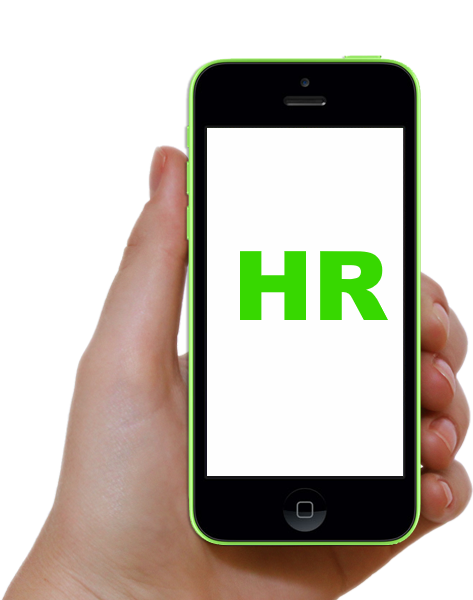
After attending a HR technology event, I always come back on a high having spent one or two days talking with positive people who are passionate about what they do in the HR tech space. HR tech continues to develop apace, and has become very user-friendly.
Having spent most of my career in HR, I sometimes wonder whether the HR end-users in attendance are there to take a serious look at what HR tech can do for their organization, or are there just to take some time out the office? The sad reality is that for the majority it is the latter - the event will soon be forgotten about as HR personnel in their organization get bogged down in day-to-day operational issues and ultimately nothing changes.
With increasing talent shortages, and with a multi-generational workforce who want to be engaged, organizations who do little to engage candidates/employees will lose out. HR needs to work faster, smarter and more efficiently than ever before, and technology is the enabler to achieve this.
There are some good tools/technologies out there that could transform how HR operates (even for small to mid-sized organizations). The consumerization of HR technology is a current focus for HR tech developers. In the U.K. alone, smartphone adoption is approximately 81%; U.K. smartphone users collectively look at their phones over a billion times a day; and tablets, one of the fastest-adopted products ever, are predicted to reach a peak market penetration of 65-70% of U.K. homes (Deloitte 2016).
HR start-up Epic Software has developed the Epic HR App. With a low-cost monthly fee option, it is accessible to small organizations. The app can be integrated with most platforms (including payroll systems) and can be branded to match organizational requirements. Epic Software enables a personal omni-channel work experience. Key features include:
- Booking leave
- Document management (including tracking of regulatory/statutory documents). CVs can also be added as a refer-a-friend initiative and air printed
- Incident management
- Learning and development – organization-specific course content can be created/added and delegates can schedule their attendance
- Engagement surveys – HR can send-out pulse surveys to measure real-time engagement
- News – branded organization/team news and videos can be loaded up, allowing employees to make comment on them in real-time
- Direct messaging (currently works one way) – HR can send out a hot message to employees if the workplace is closed at short notice due to bad weather, for example.
If an organization uses blue-tooth proximity beacons in its various locations (like those used in retail outlets) then HR can:
- Get a real-time update on the presence/absence of its employees within the region of a beacon – saves time when trying to locate an employee. The app can also be linked to Amazon’s Alexa, where the presence/absence of an employee can be confirmed simply by asking Alexa
- Show organization-specific content on screens in break-out areas, by adding digital signage in break-out areas.
However, it is not just the HR start-ups making an impact. The “Avature In-Store for Retail Recruiting” solution utilizes technology associated with an omni-channel shopping experience. The app is designed for store managers to enable hiring at short-notice. Key features include:
- Access to a database of former employees, silver medallists and talent pools
- A dashboard enabling them to view open jobs, status (candidates, interviews, offers, hires) and manage actions to be taken. Candidates can be compared on key criteria such as shift availability or behavioral assessment scores (based on pre-loaded questions)
- One-Click Review to quickly move candidates forward or decline them
- Templates to create job descriptions/offers/onboarding schedules, etc.
A candidate can determine location preferences for job opportunities, and can engage with the retailer in several ways:
- Online – via a branded, mobile-enabled career site; application via social media; has Google Maps feature as a store locator
- Walk-in – by downloading a QR or SMS code (advertised via an in-store poster/digital signage) which triggers a fast apply process; or via the Fast Apply app on an in-store mobile device. Candidates can also scan upload a paper CV onto the instore mobile device.
This is a truly omni-channel candidate/employee engagement solution, which could easily be applied to other sectors, not just retail.
My recent visit to HR Tech World in London didn’t disappoint; while I have focused on just two of the exhibitors, there were many other HR tech companies in attendance who are also consumerizing their solutions. HR technology will soon no longer be accessible just to employees with a workplace desktop or laptop. Consumerization of HR tech will enable organizations to use technology to engage with all employees/ candidates and this will be one of the key attributes of the workplace of the future.
]]>And, at the same time that basic accounting processes are being automated, so is financial reporting and analytics. Here, natural language generation coupled with analytics is leading to automatic reporting and interpretation of results while predictive and prescriptive analytics are increasingly identifying appropriate company behavior.
Finally, as the operational accounting and reporting processes become automated, the outsourcing vendors are increasingly moving upstream into financial planning and analysis.
So, the nature of finance & accounting is undergoing dramatic transformation. But can the same be said for the role of the CFO? So far this seems to be relatively unchanged, and we believe the time is right for a corresponding transformation.
Hence, NelsonHall tasked its HR department to identify a new CFO for the modern age. In the spirit of design thinking and achieving 10X impact, we thought, “Why not change the role, so that involvement with the CFO, rather than increasing the stress of all concerned (as has often been our experience due to the usual requests for budget cuts and increased performance), actually lowered the stress of all concerned and enhanced the mental health of the organization?”. This would be a truly transformational outcome.
So we set out with a charter to change the role of the CFO from stress-inducing to stress-reducing and to measure the falls in blood pressure of personnel after encounters with the CFO. And while we don’t yet have definitive quantitative results, I think we can confidently assert that this approach is working in the initial pilots.
We decided to look beyond the CFO stereotype of someone with traditional finance skills and a laser focus on analysis, reporting and control. In fact (and this might be a useful tip for executive recruitment agencies), we used the latest thinking in talent acquisition and “consumerized” our hiring process. The result was a generation Z hire (born after 2000) who displays none of the uptight characteristics normally associated with a CFO. We believe he’s a real cool cat.
His background is unknown (background checking was something of an issue), but then why adopt traditional hiring techniques when you are seeking to be transformational? Having said that, he is street-wise and knows what he wants out of his career and life in general.
In terms of daily routine, he turns up for work at about 07.30 in the morning. He commences his duties in corporate stress reduction by welcoming each employee with a purr, and following a breakfast (we presume his second breakfast) he purrs even more. Purring actually has healing properties – it makes the human heart-rate slow down, it lowers blood pressure and stress, and it boosts the immune system, enabling humans to better cope with the day-to-day tasks. So, a truly transformational impact in the role of the CFO.
We thought you might be interested to find out more about our CFO (Chief Feline Officer) Leo’s typical day in the office, so we have outlined this below as an example to all organizations considering taking this approach:
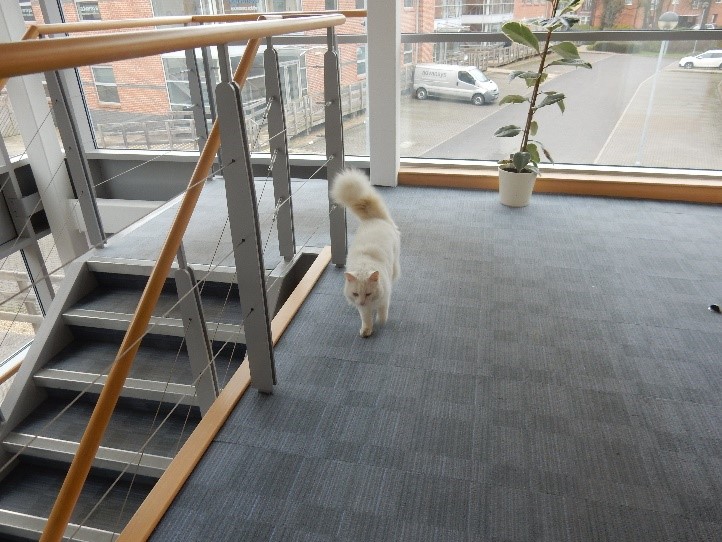
07.30: Leo arrives at work, bright eyed and bushy tailed, looking forward to his second breakfast.

07.31: “Let me in please……I want my second breakfast.” He’s keen.

07.35: “That’s better……I feel I can start the day how I mean to go on.”

07.45: “Now what shall I do?......That’s a nice photograph of me……I’m quite handsome, aren’t I?” Who said CFOs were posers?
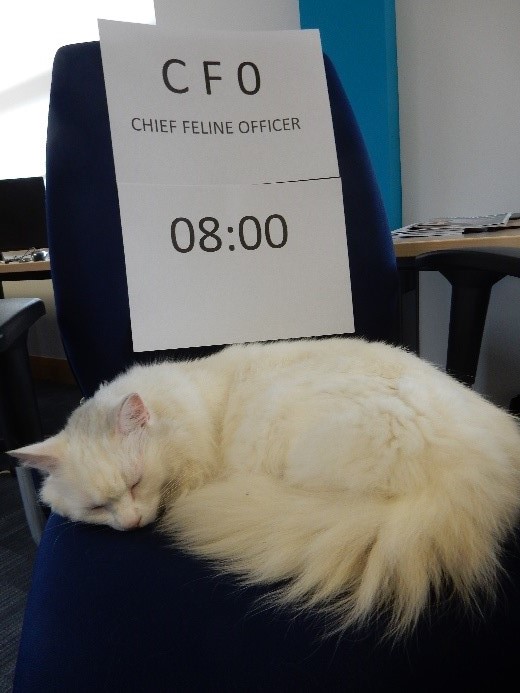
08:00: Zzzzzz
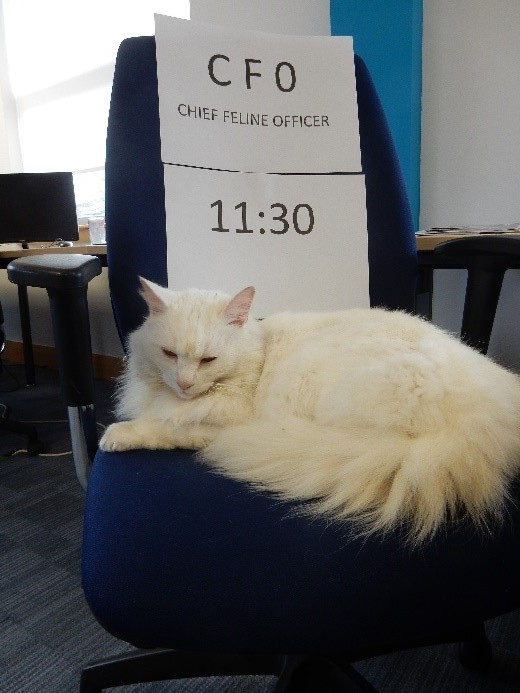
11.30: “Is it lunch time yet?......Oh well, I might go back to sleep!”
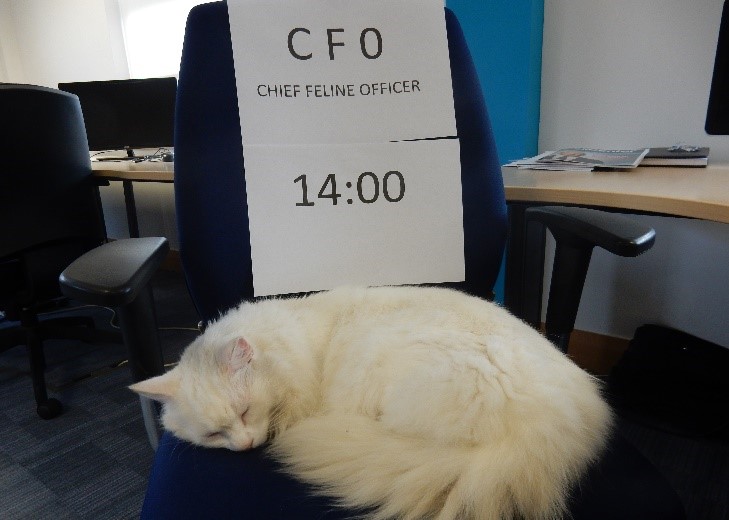
14.00: Zzzzzzzzzzzzzzzz

15:00: “Not impressed with the task list for today……anyway, we’ve gone digital, so I don’t need this paper, but it’s great to sit on! Maybe I’ll get some more sleep.”
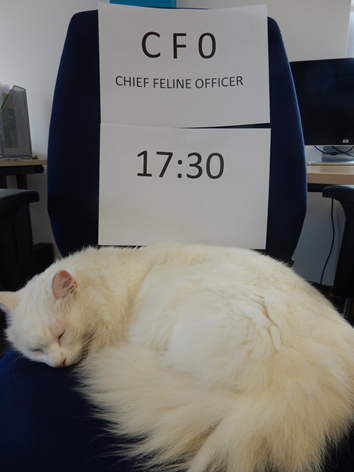
17:30: Zzzzzzzzzzzzzzzzzzzzzz

18:30: Time to leave, but this guy is a workaholic. “The only way you're going to get me out of the door is to feed me some more cat biscuits!”
We hope that this brief case study shows you how you might adapt the role of the CFO within your own organization to achieve a truly transformational impact on corporate well-being.
]]>- Political (Brexit uncertainty, European elections 2017-18, etc.)
- Economic (budget cut-backs, geographic/industry sector volatility, globalization, etc.)
- Social (talent shortages, multi-generational/ageing workforce, etc.)
- Technological (data/big data, analytics, “consumerization”, etc.),
- Legal (compliance/risk mitigation), and
- Environmental (ethical behaviour, paperless offices, etc.).
Whereas many larger organizations have employees or teams of employees working strategically and operationally to address some of these challenges, it can be easy to forget that small to mid-size businesses (SMBs) do not have the resources in place to tackle even the most basic of challenges.
NelsonHall recently attended NGA’s Analyst and Adviser Summit in London. A key takeaway from the event was how NGA has turned around Moorepay (its unit offering payroll and HR solutions for U.K./Ireland businesses up to 500 employees) from being in decline in 2014 (losing one in three clients) to enjoying 7% growth. Moorepay has 10k U.K. clients, and delivers 500k payslips and over 12.5k HR service engagements each month.
There would appear to be potential for growth in the U.K. SMB segment, given there are ~1.2m SMBs with 1-500 employees; however, the majority (~1.0m) of these have fewer than 10 employees. The Office for National Statistics (ONS) suggests that up to 45% of small organizations go out of business in their first five years. These figures may increase given the uncertainties around Brexit which have led many organizations to be more cautious on budget spend/investment (and many of Moorepay’s clients to be in a period of shock). Moorepay has typically seen 15% client churn each year, mostly due to clients going out of business, with some others being acquired and transition to the payroll system of the acquiring organization. Against this background of churn, in H1 2016 it added 1,000 new clients and is on track for 2000 new clients by end of April 2017
Moorepay’s success comes down to hand-holding clients on their payroll/HR journey with a focus on simplicity, compliance and functionality that can scale as a business grows in HR maturity. The journey starts by undertaking a digital HR maturity survey to establish where the client is along the dimensions of people strategy, data and technology along four levels:
- Level 1 = no formal people strategy, manual systems and filing cabinets
- Level 2 = ad hoc people strategy, partially automated systems for business
- Level 3 = reactive people strategy, automated for management, self-service, but not integrated
- Level 4 = comprehensive people strategy, automated, integrated platforms used across the business, manager and employee self-service collaboration.
Around 80% of its SMB clients sit at Levels 1-3, irrespective of their size (10 employees or 500 employees). This is very different from larger, digitally savvy organizations, some of whom are looking at using AR in their training software.
Moorepay initially deploys as core an employee database and a payroll and pensions platform. Extra modules can be added later if and when the client requires them: from on-boarding employees or managing them through an exit strategy through to more advanced functions such as performance and talent management or paperless expenses management. The solution also includes a HR Hub for centralized web storage of company policies, documentation and templates that can be securely accessed by employees, managers or administrators.
The next area to tackle is compliance. Many of Moorepay’s clients do not fully understand their legal/tax compliance obligations, so it has developed a content library (linked to the employee database) which has legally compliant document templates built-in, providing clients to with ready-made documents to use. Additions in 2016 included Health and Safety forms created in response to the HSE trebling the number of prosecutions of organizational directors for health & safety breaches and starting to charge fees for intervention (FFI) for health & safety advice on the back of £14.1bn cost of injury and illness in UK 2014/15.
Pensions auto-enrolment, launched in the U.K. back in 2014, continues to be rolled out across smaller businesses, and Moorepay still has 100 clients going through pensions auto-enrolment/month. Ongoing compliance support from Moorepay currently covers the National Living wage (since 2015), Equalities Office gender reporting (clients with over 250 employees), the Immigration Act 2016 and the Apprenticeship Levy (April 2017).
When Moorepay’s clients have a good grasp of the basics, they can scale the technology to their business need. The technology is mobile ready and leads to the required page by typing requirements into the toolbar. Booking leave and payslips are the two most searched items; clients can access these pages in the shortest number of clicks. When clients are ready (or if they are already a Level 4 client), they can make use of Moorepay’s reporting capabilities (standard reports needed for compliance issues, etc.), add content (documents, media, etc.), access tutorials on using the technology and even choose dashboard styles/design their own dashboard.
At the start of the payroll/HR journey, 37% of Moorepay’s SMB clients did not have any visibility of data, so getting them to see reports/graphics of relevant data, be compliant and utilize more advanced features of the technology is a successful step on that digitization journey. Client satisfaction levels have doubled in three years (2014-2016) and attrition fell to 5.5% in 2016.
So, what is next for Moorepay’s clients? In 2017 one area of focus for Moorepay is developing analytics automation capability with a third-party partner. This will help SMBs to use their people data to drive informed business decisions.
]]>
By Nikki Edwards & Gary Bragar
In recent industry discussions around talent acquisition, we have identified a number of interconnected trends that are having a significant impact on talent acquisition markets. Here, we take a look at three key trends, and at how HRO vendors in the talent acquisition space are responding.
Socio-economic trends
An ageing, yet multi-generational workforce made up of Baby boomers, Generation X, Generation Y/Millennials and Generation Z (all of whom have different views on how they should work), is complicating the war for talent: it is no longer just focused on permanent hires and contingent workers, but incorporates more complex models such as Statement of Work (SOW), Independent Contractors (ICs)/Freelancers, and the rise of the ‘gig economy’ (where an individual may be working on multiple gigs at any one time).
Vendors are responding by focusing on creative pooling for talent acquisition outsourcing (both RPO and MSP), looking across gender, diversity, veterans, alumni, women returners, university, sectors, geographies, skills, etc. Some MSP vendors are offering services procurement management solutions (managing SOW, ICs, direct sourcing), and offering services around clients’ employer value proposition, and strategic workforce planning, to attract talent.
Talent acquisition trends driven by market maturity
The availability of larger corporations with whom to initially engage in talent acquisition outsourcing is nearing saturation point in the mature markets of U.S., U.K., much of Europe, and Australasia. These corporations, having been the first to consider talent acquisition outsourcing , are now three or four generations into an outsourcing model and no longer offer the growth opportunities they once did. Consequently, new opportunities lie in the mid-market space, and in newer territories (Latin America, Malaysia, China, etc.).
Cost savings made in first generation contracts are more difficult to achieve in subsequent generation contracts. Eking out further cost savings has led buyers to seek ‘total talent management’ (using one provider to manage all talent acquisition, rather than two separate providers for RPO and MSP) or more blended/tailored models (by geography, industry, business function, etc). However, with the levels of cost savings in decline, being innovative and adding value become the key drivers.
Vendors are responding by:
- Shifting towards the mid-market space and/or new territories
- Shifting towards total talent acquisition/management or blended/tailored models
- Enhancing client operational effectiveness/program optimization
- Adding extra services (consultation, insights, client engagement, training, high-touch, legal/compliance, security clearance)
- Shifting the focus of metrics to measure the effectiveness of talent acquisition outsourcing services (including rate management, innovation, strategic guidance, quality, diversity, talent retention).
Technology trends
There is no ‘one-size-fits-all’ talent acquisition technology – rather, there’s a plethora of siloed talent technologies (ATS, VMS, FMS, gig platforms, talent pooling) for different segments (RPO, MSP, Freelancers, etc.) developing at different rates and with multiple providers in each segment (some of whom will fall by the wayside). Consequently, there’s a growing trend for talent acquisition outsourcing vendors to become system integrators to access relevant data across many systems. In some cases, they are developing proprietary APIs to sit across different technologies via a single interface to access relevant data across systems. However, there is also a trend among vendors for establishing technology partnerships with providers of the latest talent technology, rather than develop proprietary solutions from scratch.
But, of course, the big technology story in HR is RPA and AI, with cognitive capabilities emerging. Cognitive tools, including IBM Watson Talent, can help recruiters prioritize and work on filling requisitions based on complexity, skill requirements, data from talent systems, how the job was filled in the past, external market insight, and what the talent supply looks like. RPA and analytics/AI are increasingly being applied to MSP and RPO to improve candidate targeting and quality. This includes analysis of candidate profiles on social networks to determine who is more likely to be receptive to solicitations for jobs, and analytics that show which combinations of words in a job posting generate the most response (and linking them to the quality of the candidates who were ultimately hired).
Nikki, Gary, and NelsonHall’s other lead HRO analysts, Amy Gurchensky and Pete Tiliakos, will be keeping you abreast of all major developments in HRO throughout 2017. To find out about NelsonHall’s extensive research plans for HRO in 2017, contact Guy Saunders.
]]>